by GardenLover | Aug 17, 2015 | Special Topic
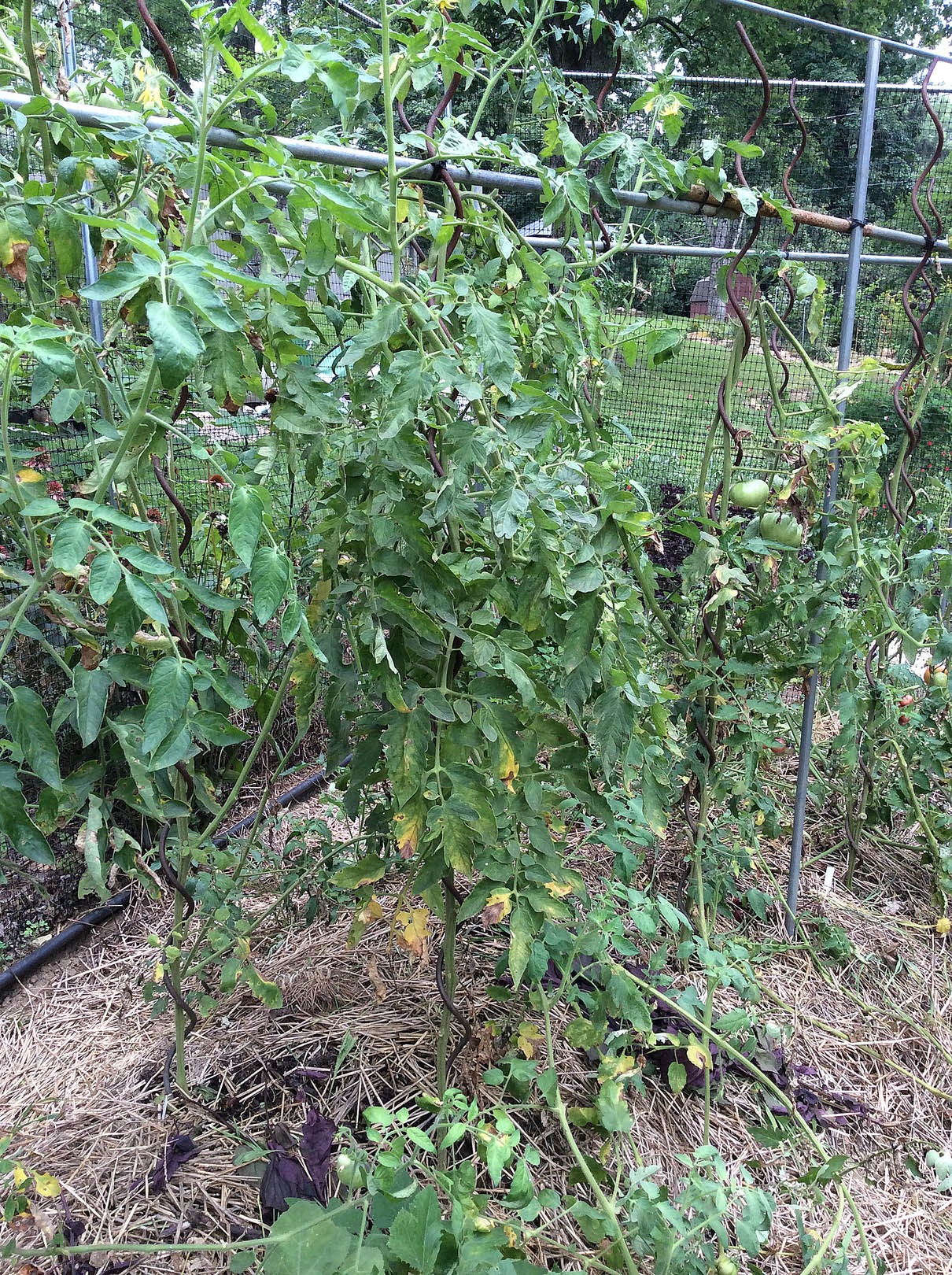 By Debra Knapke
By Debra Knapke
Late summer: the time of year when I look at the abundance of my garden and start taking away what is too much: pruning, thinning and removing diseased plants. I call this simplifying the garden and opening up space for ideas gleaned from seminars, trade shows and garden tours.
But first, I have to deal with nature’s effects on the edibles.
We can all agree that this has been another challenging growing year. Mother Nature has muddled the spring and summer seasons with excessive rain and unseasonable lower temperatures. By the last week in June, my tomato plants were gorgeous; loaded with blossoms and fruit… all green. We had lots of rain and little sun in May and June. The temperatures – while delightful for humans – were not hot enough to develop colorful and tasty fruit. By the second week of July early blight plus Septoria leaf spot showed up on tomato leaves – see above.
We finally had some hot, sunny days in July, but this generated severe sunscald on the tomatoes. They were not accustomed to sunny days. Low temperatures caused most of my tomatoes to ripen unevenly resulting in irregular coloration, white spotting, mealy texture and little true tomato flavor. To add insult to injury, anthracnose lesions developed on the tomatoes that were ripening well.
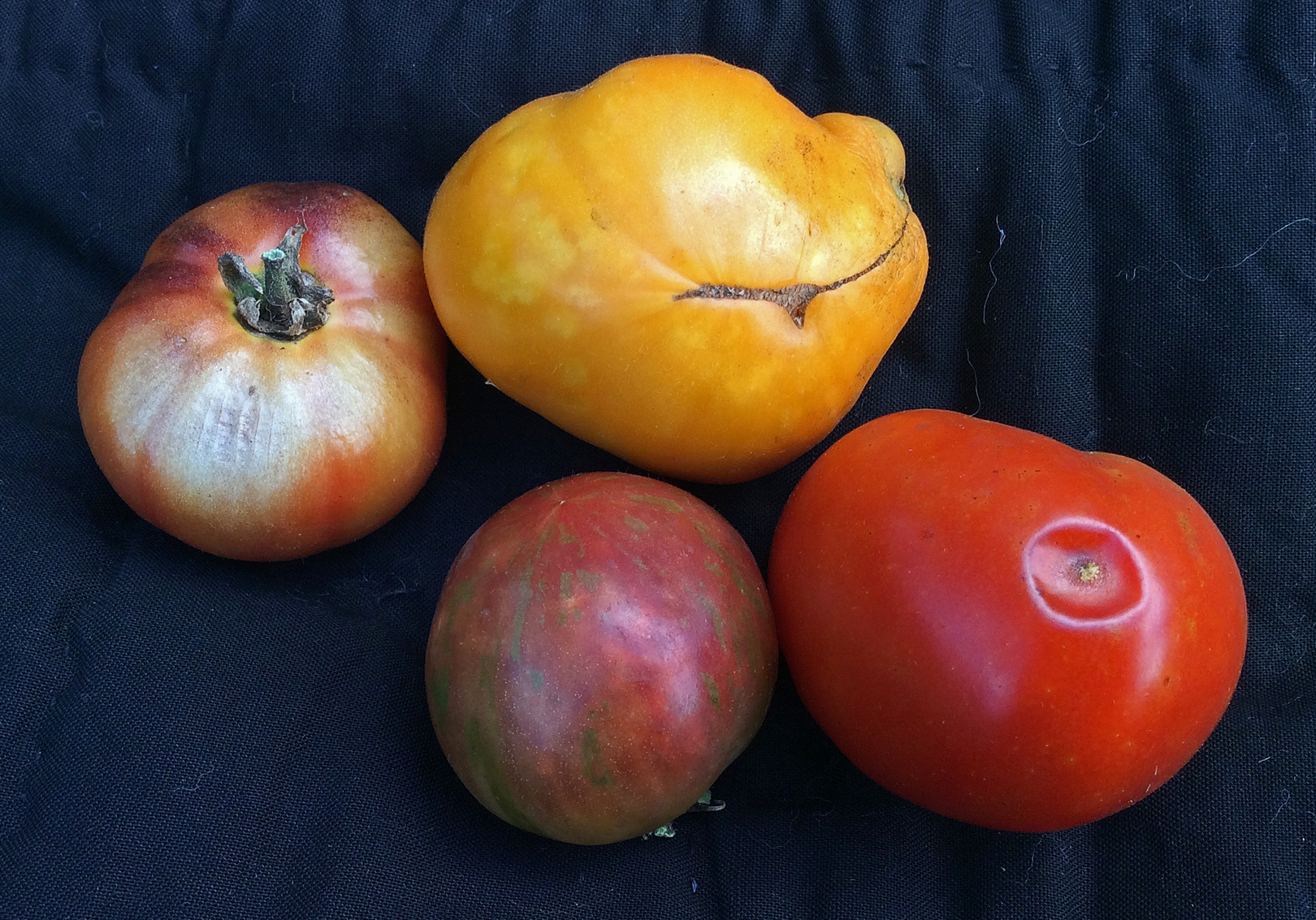
Left to right: Black Krim tomato with sunscald, middle Black Krim and Gold Medal tomatoes show mottled coloration that indicates low temperature conditions and lastly, an undersized Brandywine tomato with anthracnose.
Are these tomatoes safe to eat? Yes, but after you remove all the diseased sections, there isn’t much left. What does one do with tomatoes such as these? Make tomato sauce.
Now, I have plants that are covered with disease. This calls for an experiment. I removed all diseased portions of each plant, rinsing my pruners and fingers in 91% alcohol as I moved from plant to plant. I cleaned up the area under the plants and then watered in a low nitrogen organic fertilizer. These are my Charley Brown tomato plants, and I wonder if they will be able to rebound from all of the above.
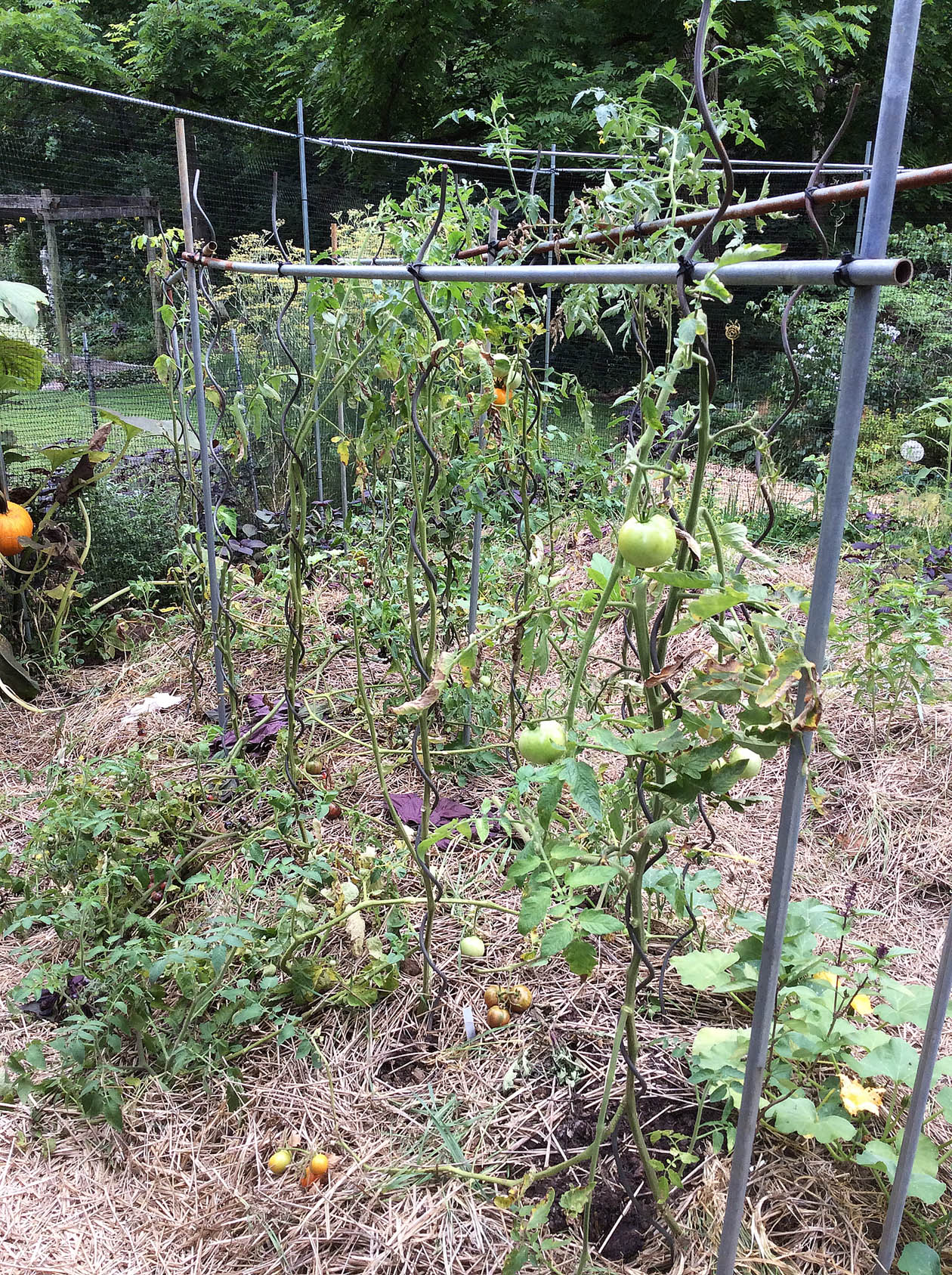 Next sad story concerns basil. I started my own plants this year in an effort to bypass the downy mildew disease that has plagued my favorite pesto herb. My 32 plants started off great. I kept them evenly moist and healthy with compost tea. Just as I was thinking to plant them out – late May – I noticed my plants had downy mildew.
Next sad story concerns basil. I started my own plants this year in an effort to bypass the downy mildew disease that has plagued my favorite pesto herb. My 32 plants started off great. I kept them evenly moist and healthy with compost tea. Just as I was thinking to plant them out – late May – I noticed my plants had downy mildew.
Here, it is important to explain what downy mildew is. First, it is not a fungus. Therefore, a fungicide will not be effective on this pathogen. It is a water “mold” in the Kingdom Protista. TMI? Maybe, but if you are going to try to defeat it, you have to understand its nature. This is not a post about downy mildew, but it is important to understand that it is a difficult disease to control. We do not have a cure, instead we have to prevent it with cultural and mechanical practices:
- Clean up all plant debris and remove infected leaves
- Sterilize your tools and fingers frequently with alcohol when removing diseased parts from plants
- Keep the plants healthy by side-dressing with compost
- Do not allow the soil to dry out – avoid water stress.
Below are three infected leaves. On the left is the top of the leaf. Notice the blotchy yellowing. The other two leaves show the “gray” infected areas under the leaf.
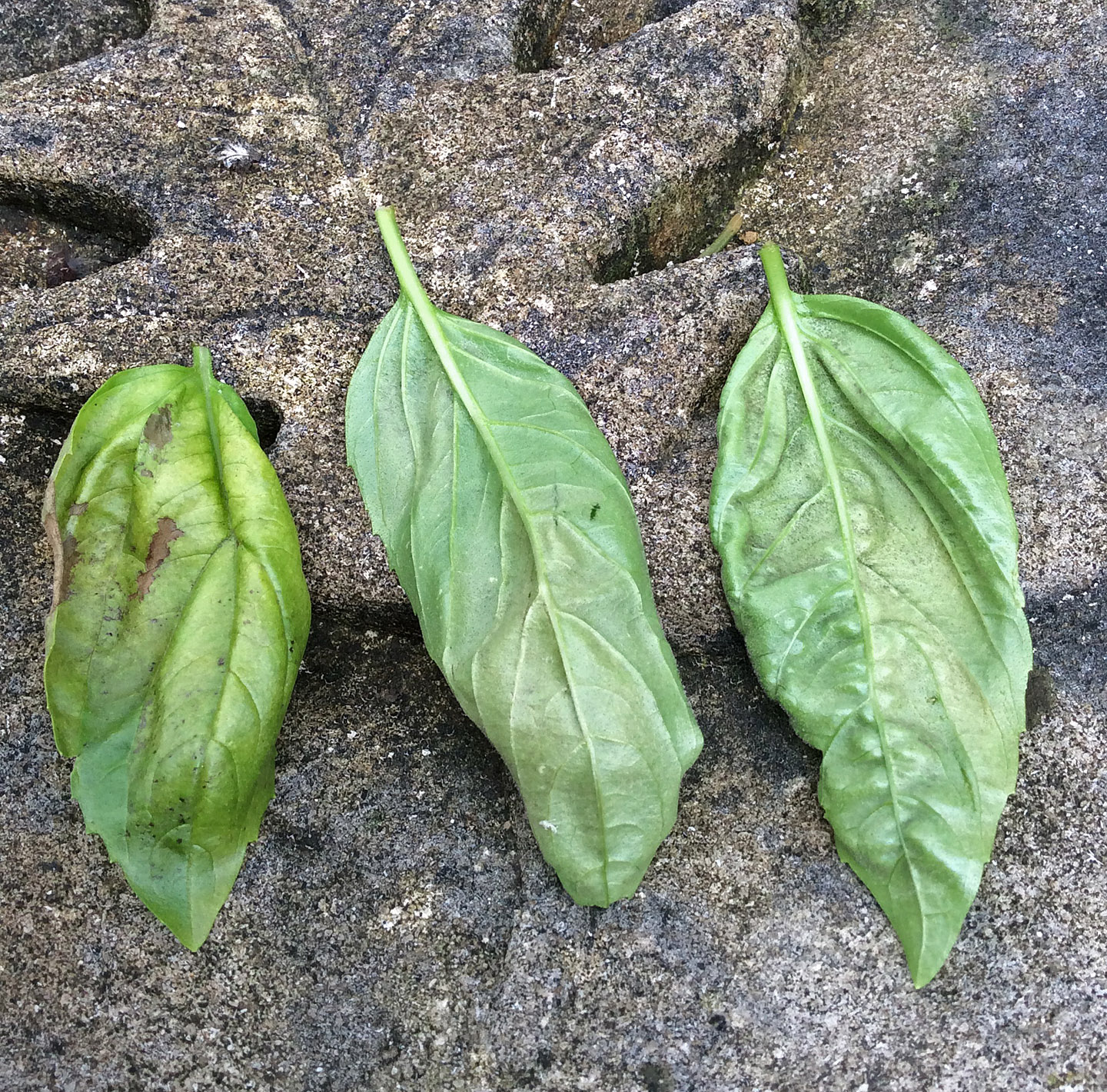 Take a closer look and you can see the spores; the carriers of downy mildew to the next leaf or plant.
Take a closer look and you can see the spores; the carriers of downy mildew to the next leaf or plant.
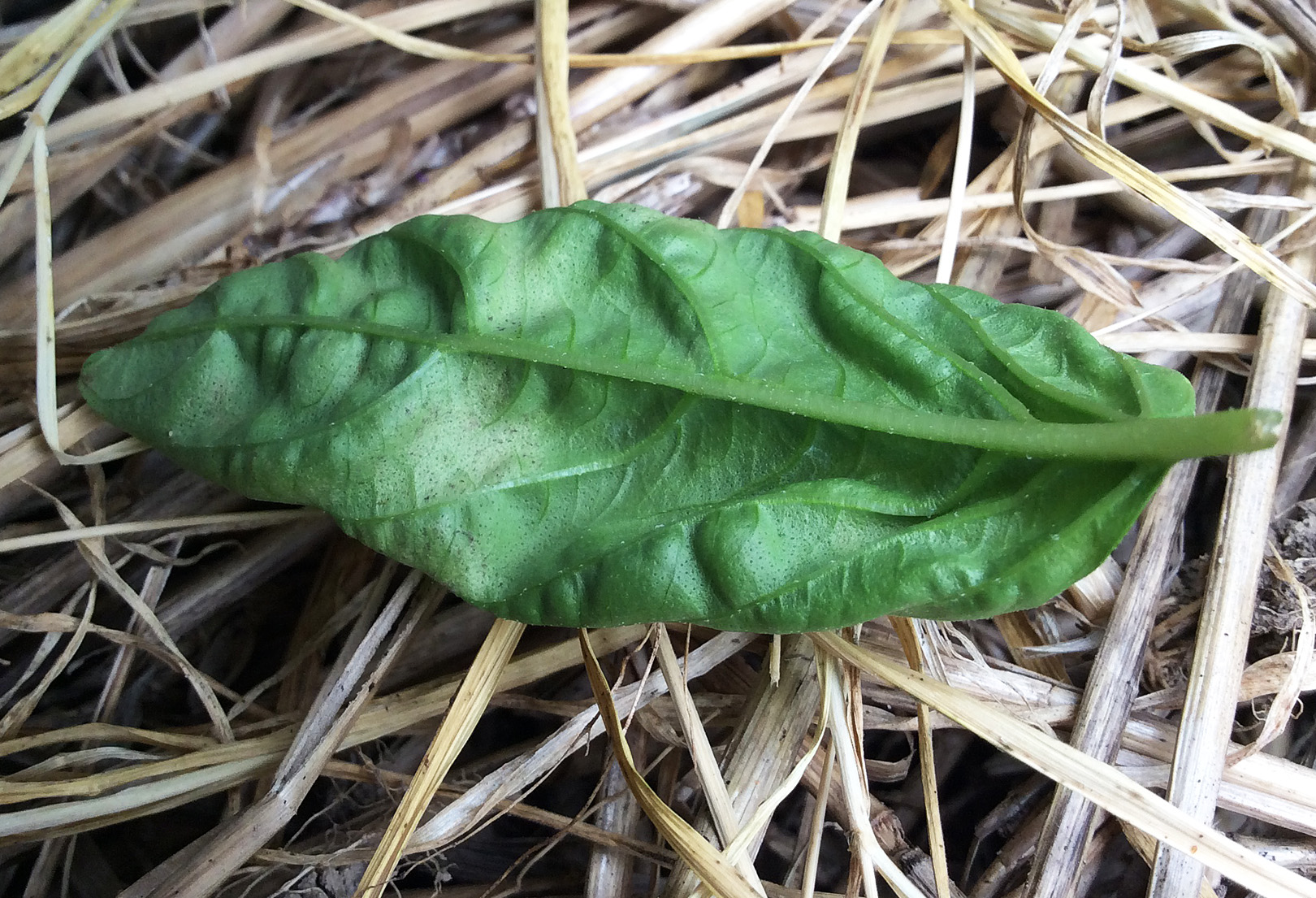 The below plant was doing well, but I was at a conference for a week and this is what I found when I returned.
The below plant was doing well, but I was at a conference for a week and this is what I found when I returned.
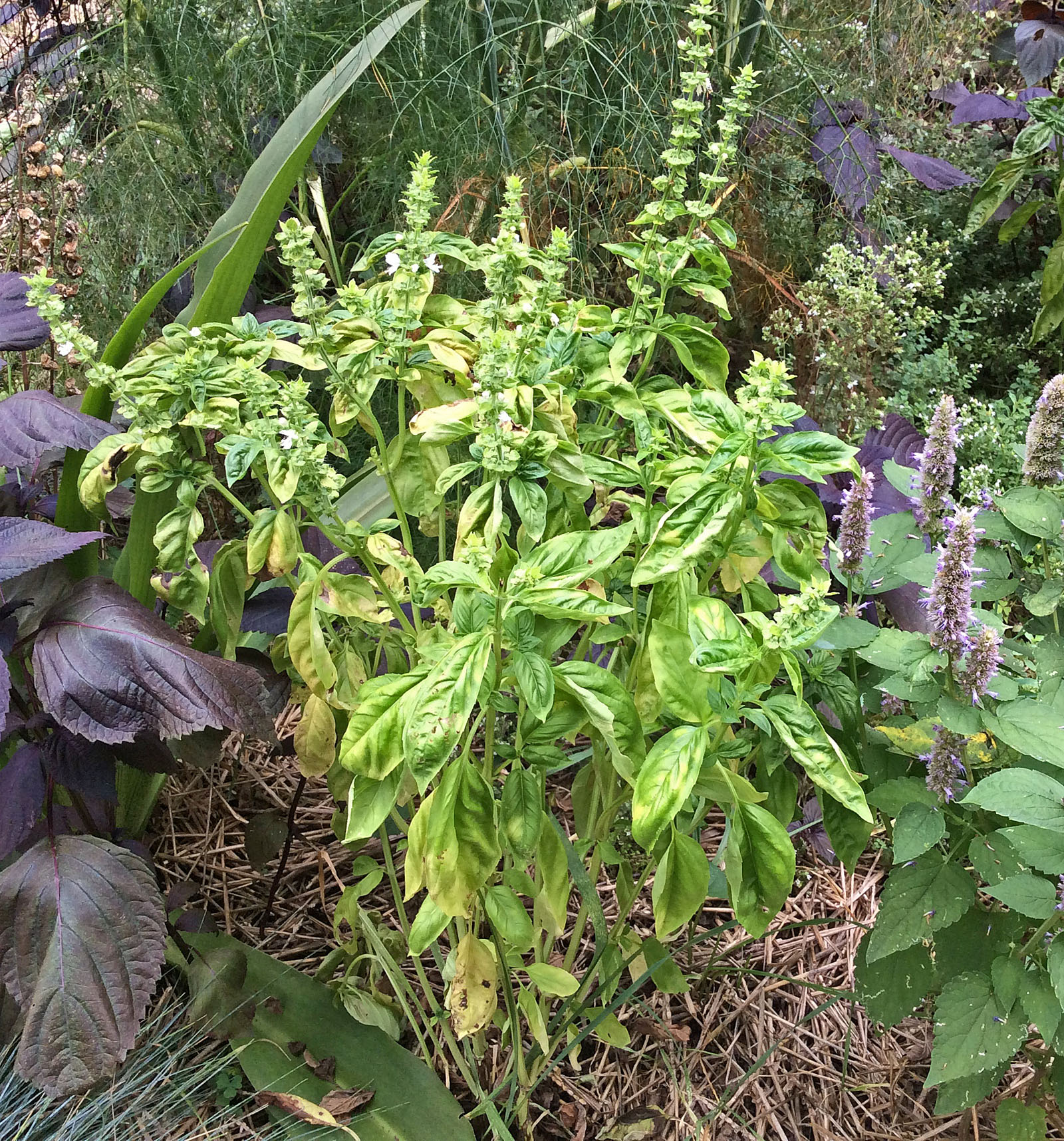
Downy mildew has returned. I missed my pesto-making window. This plant has been moved to the “bad” compost pile.
I have since destroyed my most affected plants – the triage – and then removed affected leaves from the healthier plants. I am trying a product: BioSafe Disease Control. It is based on hydrogen peroxide which has been shown to have a preventative effect on water molds. I will let you know.
There are other tales of woe, like swamped lavenders, and tales of joy: having the best summer phlox bloom ever. But that is for the next post.
Wishing you excellent pesto and tomatoes…
by GardenLover | Aug 13, 2015 | Special Topic
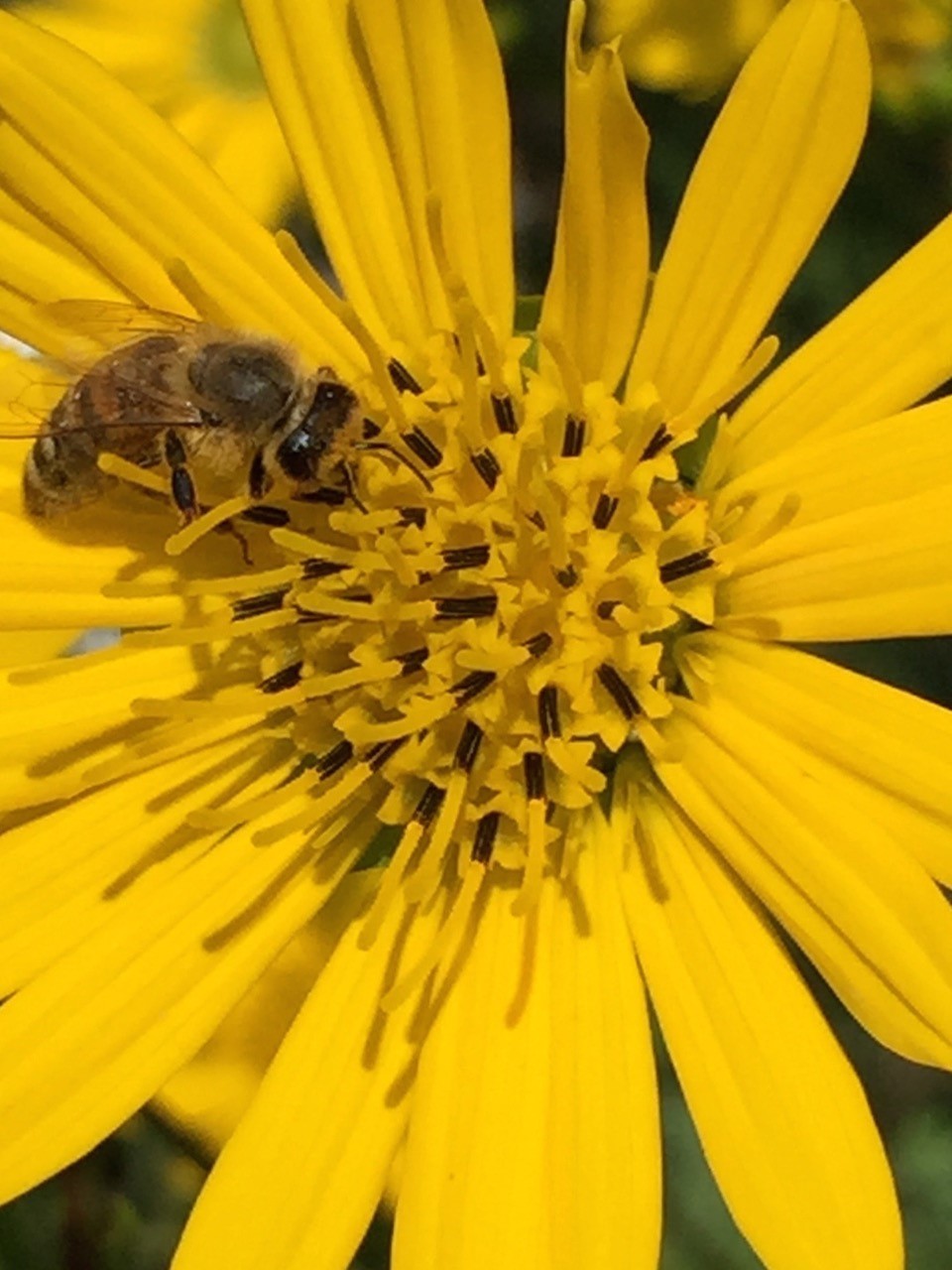
Beleaguered bees attacked by drugs, diet and deadly sprays
By Michael Leach
I went to the workshop hoping for a simple explanation of honey bee problems caused by pesticides called neonicotinoids, a relatively new class that’s blamed for bee deaths.
Turns out, there’s no sound bite or even a half dozen. Explaining honey bee problems is only slightly less complicated than charting the latest Greek financial bailout or hedge funds.
There is, however, an easy way to reduce insecticide dangers — don’t spray while plants are flowering.
This is the only simple take away from an update by Luis Canas, associate professor of entomology at The Ohio State University. In July, he spoke at “Cultivate 15” in Columbus. Produced by AmericanHort (a horticulture and landscape industry association), the event is one of the nation’s premiere floriculture trade shows. It incorporates OSU short courses, such as the one presented by Professor Canas.
As an “apprentice” beekeeper for the past couple years, I was vaguely aware of ills facing honey bees. The workshop expanded the gloomy horizon of colony collapse disorder (the term used for the sudden disappearance of honey bees) which is a worldwide problem.
For instance, one of the biggest problems is varroa mites (which have the perfect scientific name Varroa destructor). These tiny parasites deform wings and other body parts. Add more challenges: 1) tracheal mites that affect the bee’s ability to breathe; 2) negative side effects of drugs given to bees to protect them against bacterial diseases; 3) gut parasites; 4) poor nutrition; and 5) habitat loss.
Here in the Midwest we can also add Arctic vortex to the 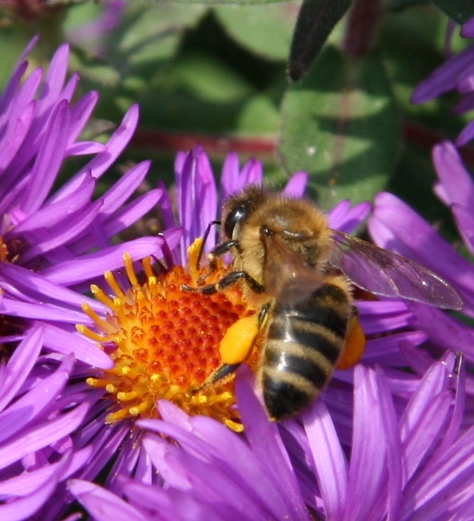 list. The past two frigid winters decimated hives, about half died in my hometown region this winter.
list. The past two frigid winters decimated hives, about half died in my hometown region this winter.
Despite these woes, there are an estimated 2.6 million hives in the U.S. Sounds pretty good until compared to 6 million hives tallied in 1945.
What’s to be done? Following label directions and precautions are obvious ways to cut pesticide dangers. But even the best safety intentions can be thwarted with toxic substances.
Bees forage in a 6-mile diameter circle from their hive. A lot can happen in that much territory. Wind carries agricultural dust from chemicals used on corn and soybean seeds to nearby plants.
Systemic insecticides, which are absorbed by the plant, eliminate the air-borne dangers of drift but may still cause problems. If applied to greenhouse plants early in the season, they will probably dissipate before transplanting into fields or flower beds. But such products used before shipment to retailers are likely to harm pollinators because the insects will be gathering freshly tainted nectar and pollen.
Systemics used as soil drenches to protect home landscape plants endanger bees. The pesticide’s toxic ingredients can move through the soil and be absorbed by non-target plants. Pollen is tainted.
Some types of chemicals disorient bees, causing them to be confused and unable to return to the hive.
Biological pest management techniques and fine horticultural oils that have no lingering effects, are being used by some growers. As a budding beekeeper and supporter of pollinators in general, I’m hoping for breakthroughs here. Perhaps such approaches are the future for large-scale growers, too. Let’s hope something much less toxic comes along soon.
Until then, pesticide applicators please use extreme care or better yet, find alternatives. In our inter-related world, we all live down stream — or down wind. If it hurts bees, what about us?
Tips to make your outdoor space pollinator (and wildlife) friendly
You can help pollinators whether your “backyard” is an estate or an apartment balcony. Here are two helpful links:
by GardenLover | Aug 7, 2015 | Special Topic
By Teresa Woodard
I wish I had a garden fitness app. You know, one that tracks the number of weeds pulled, the pounds of soil turned, the yards of mulch spread, the linear feet of shrubs trimmed or the number of branches pruned. Call it MapMyGarden, DigMyMuscles or WeedtoWin.
In spring, my charts would climb as I eagerly dive into a new growing season. The numbers would likely peak in May, when I, like so many other gardeners, work double-time to keep up with never-ending chore lists. This summer’s rains certainly made it tougher to stay ahead of the vigorous, multiplying weeds.
However, the stats this time of year would likely take a big drop when my enthusiasm wanes. As the temperatures soar and mosquitos swarm, I definitely could use a fitness app’s pep talk to stay the course and finish the season strong. And maybe a on-line coupon for repellant.
Perhaps, the app could translate all my gardening activities into calories burned or muscles built. I might even reward my efforts with an extra scoop of ice cream on a bowl of cherry crisp or not feel so bad about slathering a fresh ear of corn with a layer of butter.
App or no app, I do know the garden is a “free gym” that offers the benefits of exercise plus beautiful foliage and flowers, fresh air, a dose of the sunshine’s vitamin D and stress relief by connecting with the great outdoors. Besides, it’s in my own backyard.
by GardenLover | Jul 21, 2015 | Garden profile
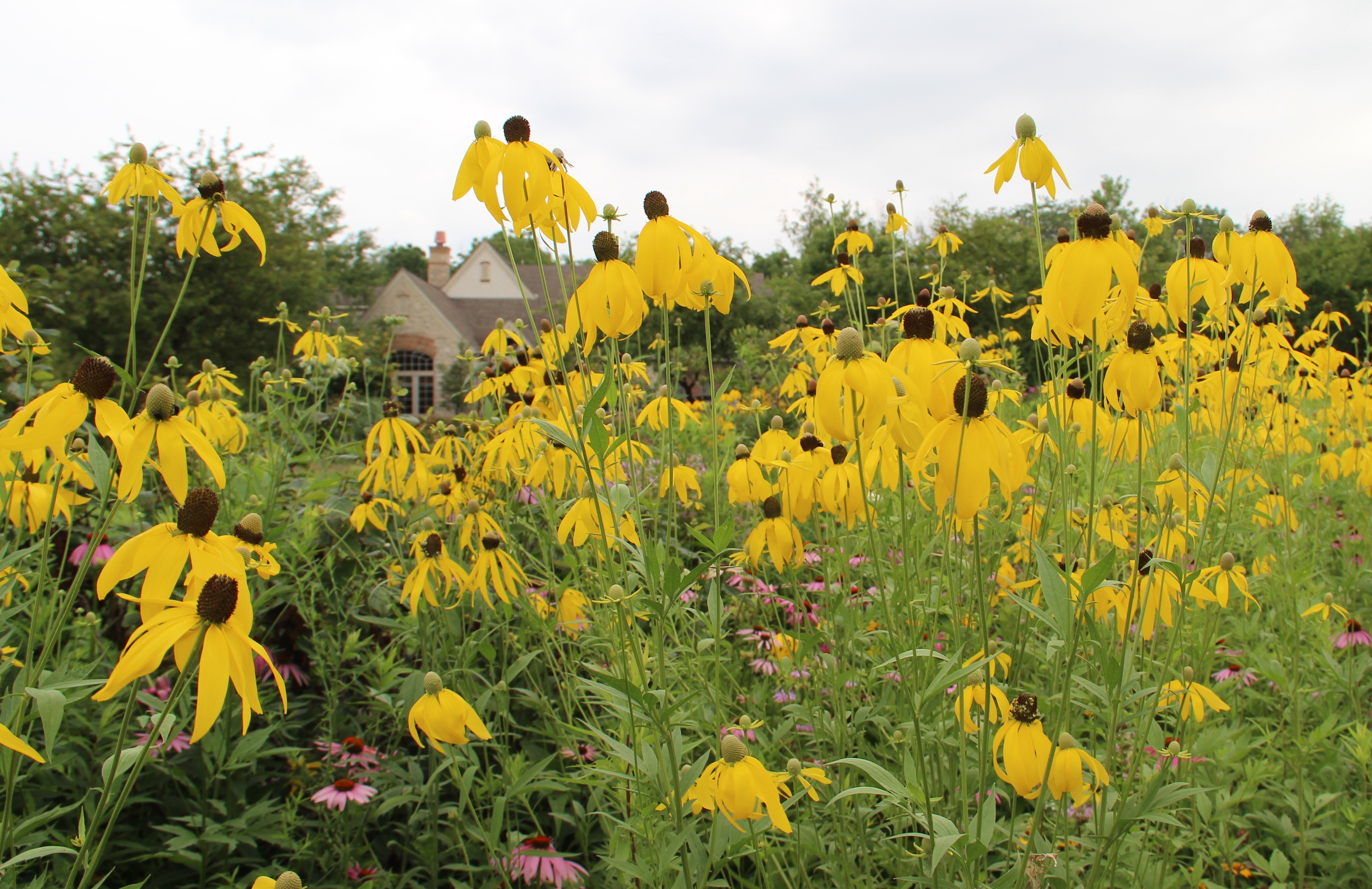 By Debra Knapke
By Debra Knapke
In between light rain showers Michael and I visited Teresa’s garden. Nestled in a conservation area along the scenic Little Darby Creek, Teresa created a haven for wildlife and for herself and her family. Her design is a continuum: formal elements by the house; semi-formal beds further out, culminating in prairie areas by the road. Her gardens reflect not only the natural areas that were along the Little Darby before humans settled here, but also of the food and cutting gardens that came after.

The Midwest is experiencing a record-setting amount of rain for June and July, so Teresa’s gardens are lush. The long prairie areas that line the road are full of bloom as we move into high summer color.
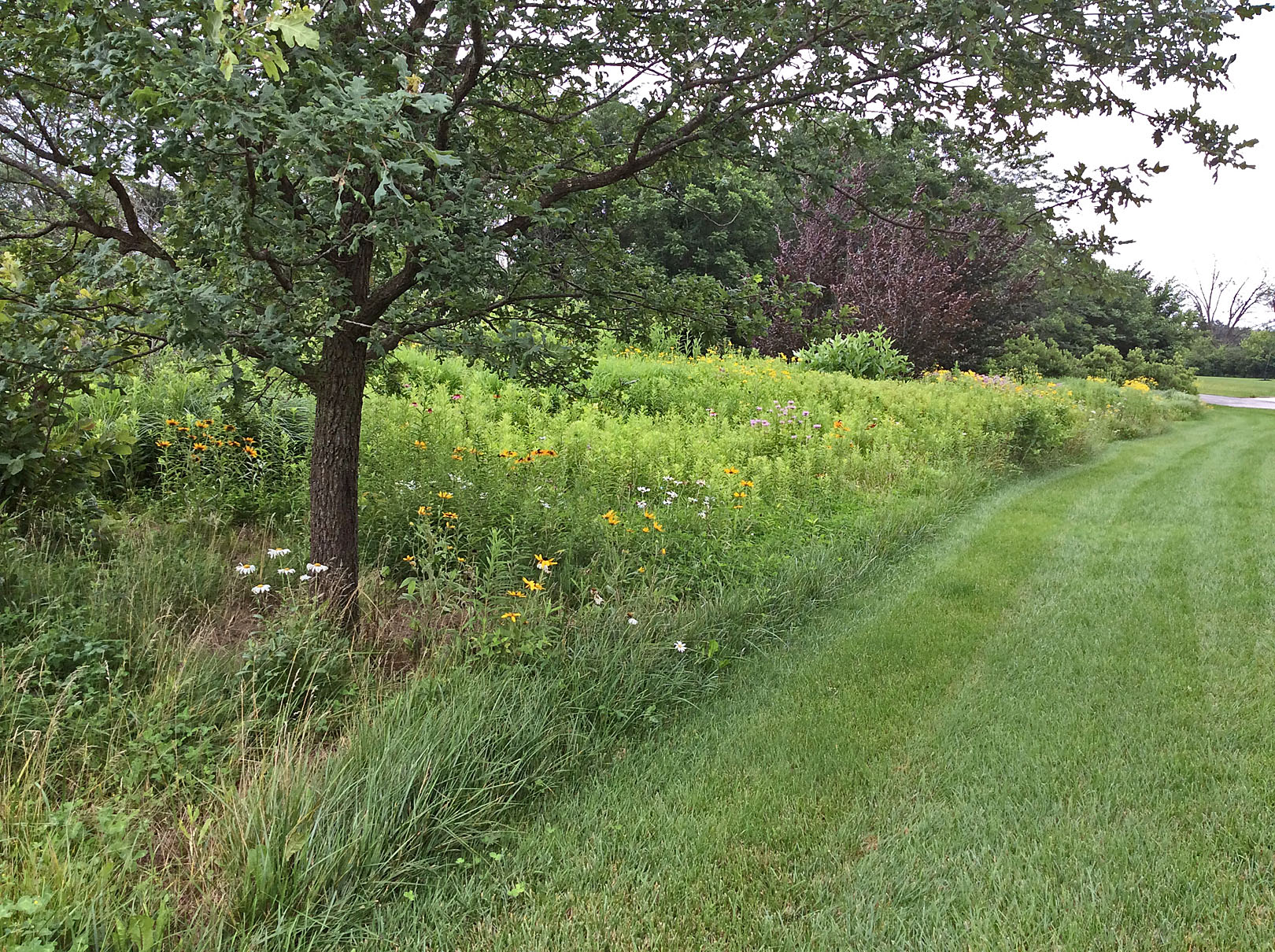 We are greeted at the front door by one of Teresa’s many colorful containers. Her gardens are lovely contrasts of textural foliage punctuated by well-placed blooming plants and artful placements of garden accents.
We are greeted at the front door by one of Teresa’s many colorful containers. Her gardens are lovely contrasts of textural foliage punctuated by well-placed blooming plants and artful placements of garden accents.
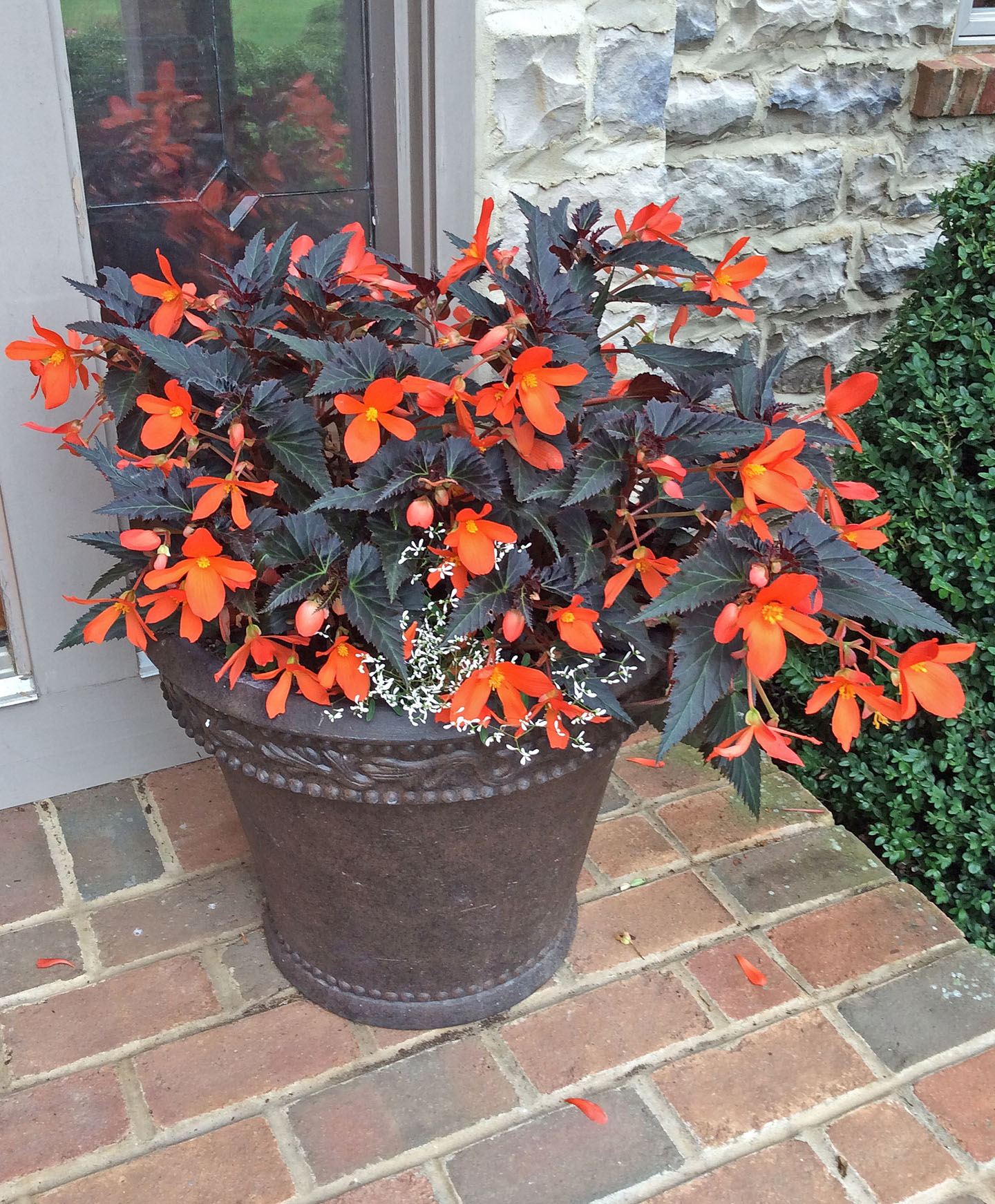
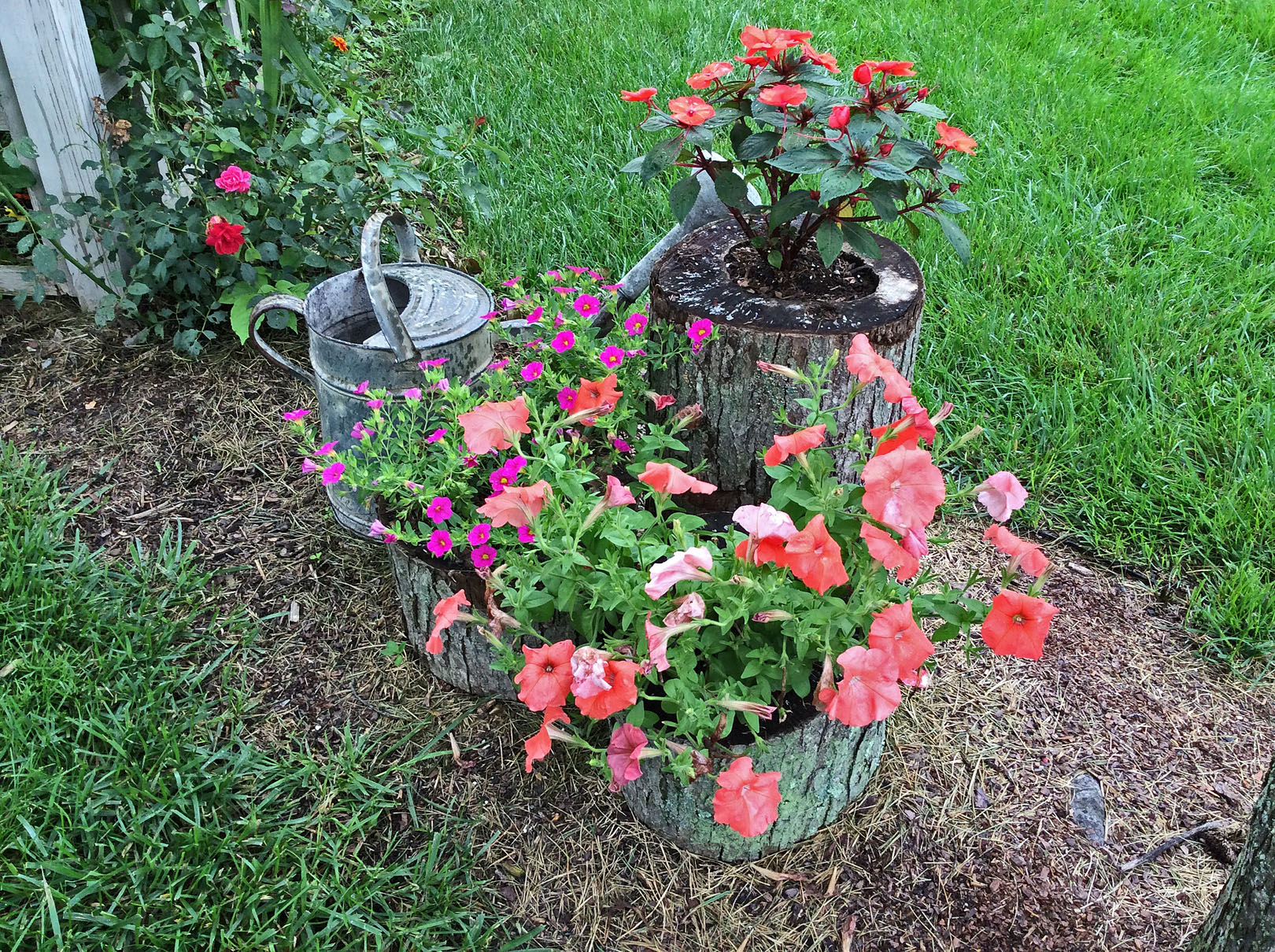
The vegetable-cutting garden is perfectly placed within easy access to Teresa’s workroom. The mass of crocosmia that you see below provided the flowers for a simple arrangement in the kitchen. The garden itself is an interesting interpretation a four-square design. Instead of opting for the traditional, Teresa created a more modern zig-zag design.
We can’t always control where our plants will roam. A volunteer pumpkin has escaped and entwined with butterflyweed. On the other side of the garden, Teresa purposely inter-planted potatoes with asparagus, purple coneflower and kiwi. The sacred Datura (right image; lower left) self-seeds as it will.
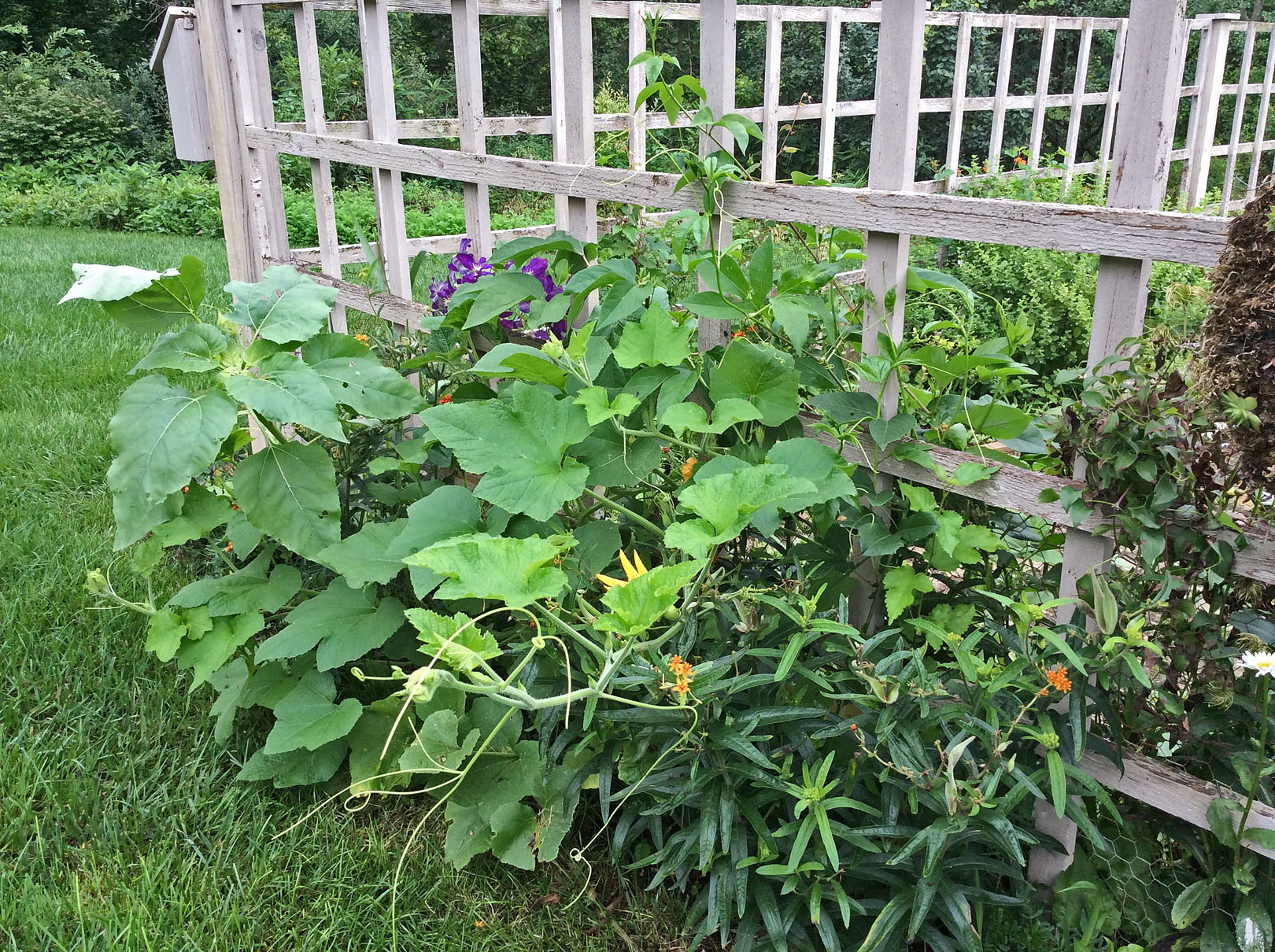
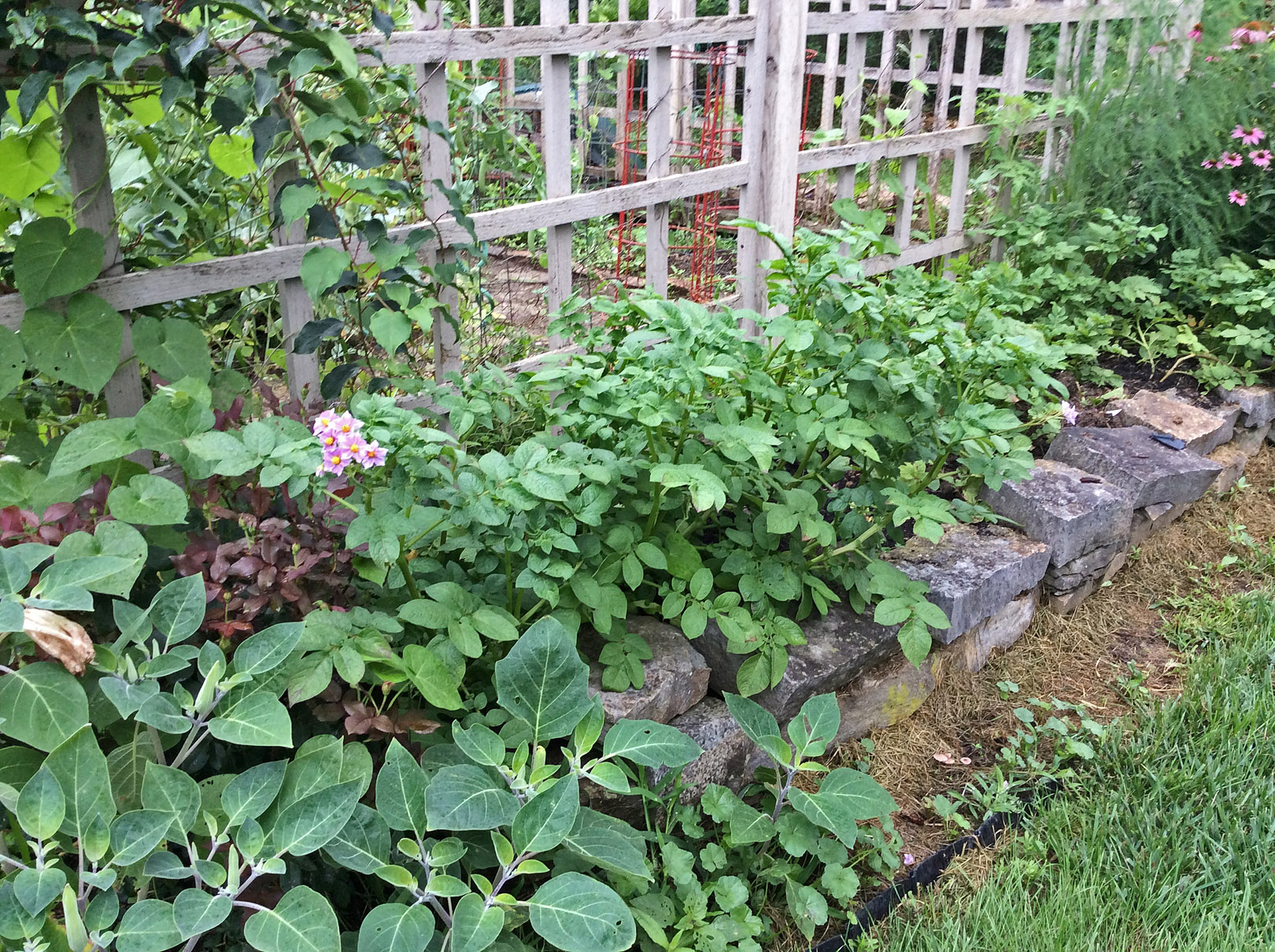
Onto the prairie – A personal favorite is false sunflower (Heliopsis sp.) which has spread along one portion of the prairie area. A close-up of another section reveals the intermingling of other prairie species. The patterns ebb and flow over the years depending on environmental conditions. Because of the rain, there were fewer pollinators present, but I have visited on a sunny day and the prairie was buzzing with a myriad of insects. The goldfinches are already harvesting the purple coneflowers.
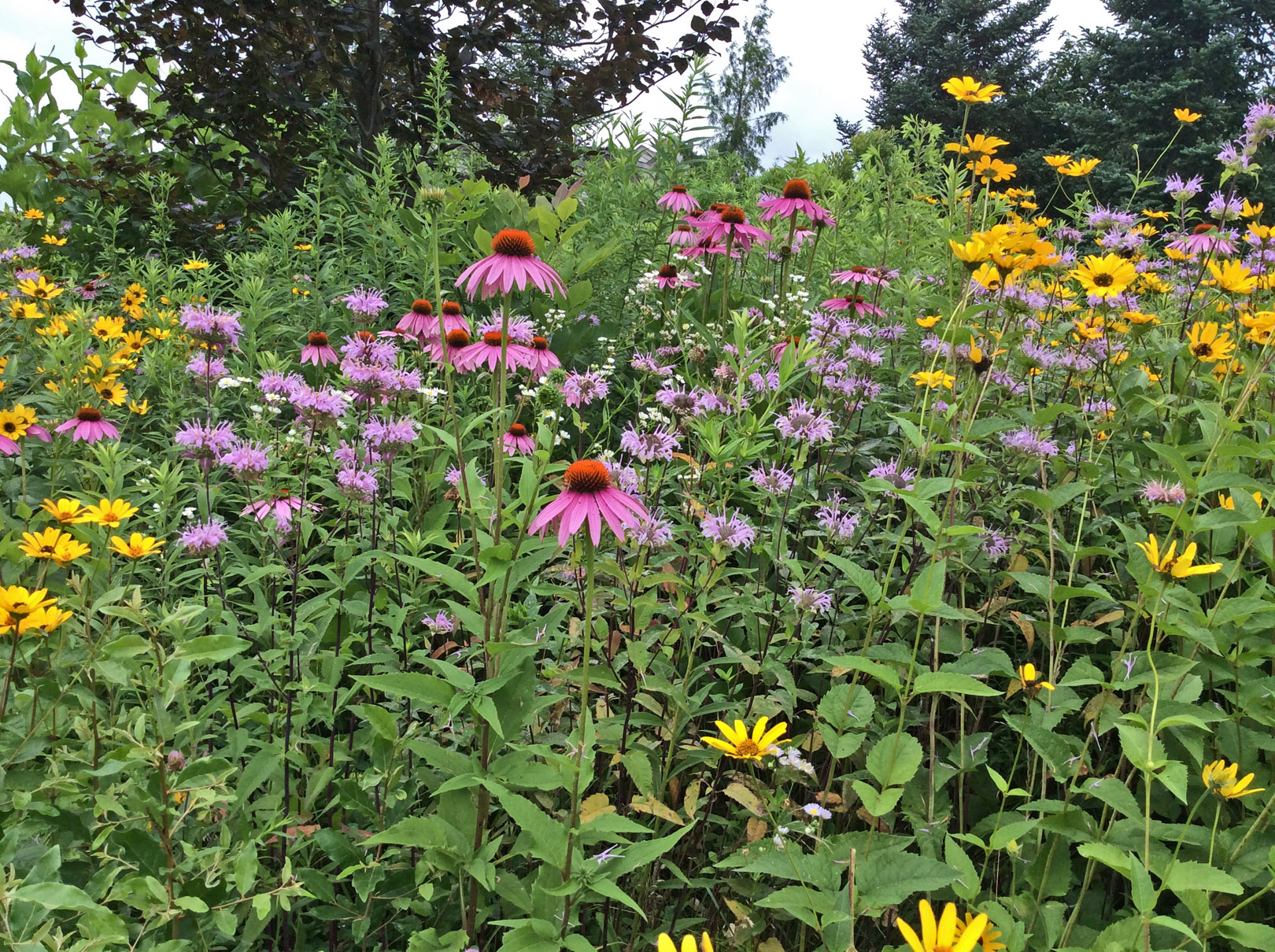
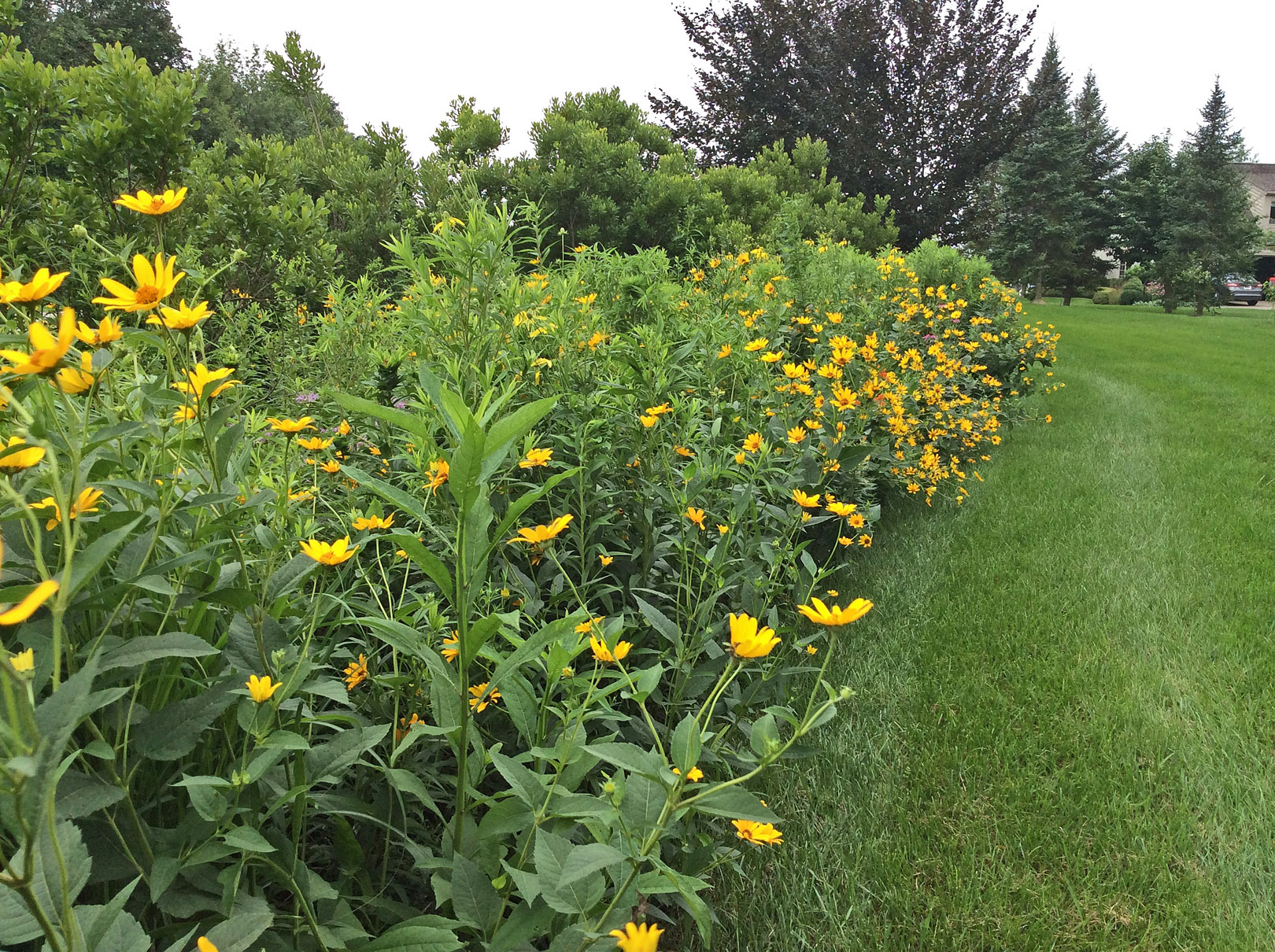
Next stop: visiting Teresa’s woods. Her son Mark installed a zip line and built a small treehouse and has made this part of the yard his own. We decided not to venture into this natural area because the mosquitoes were – quite literally – out for our blood! It was easier to avoid them by staying out in the open, breezy areas.
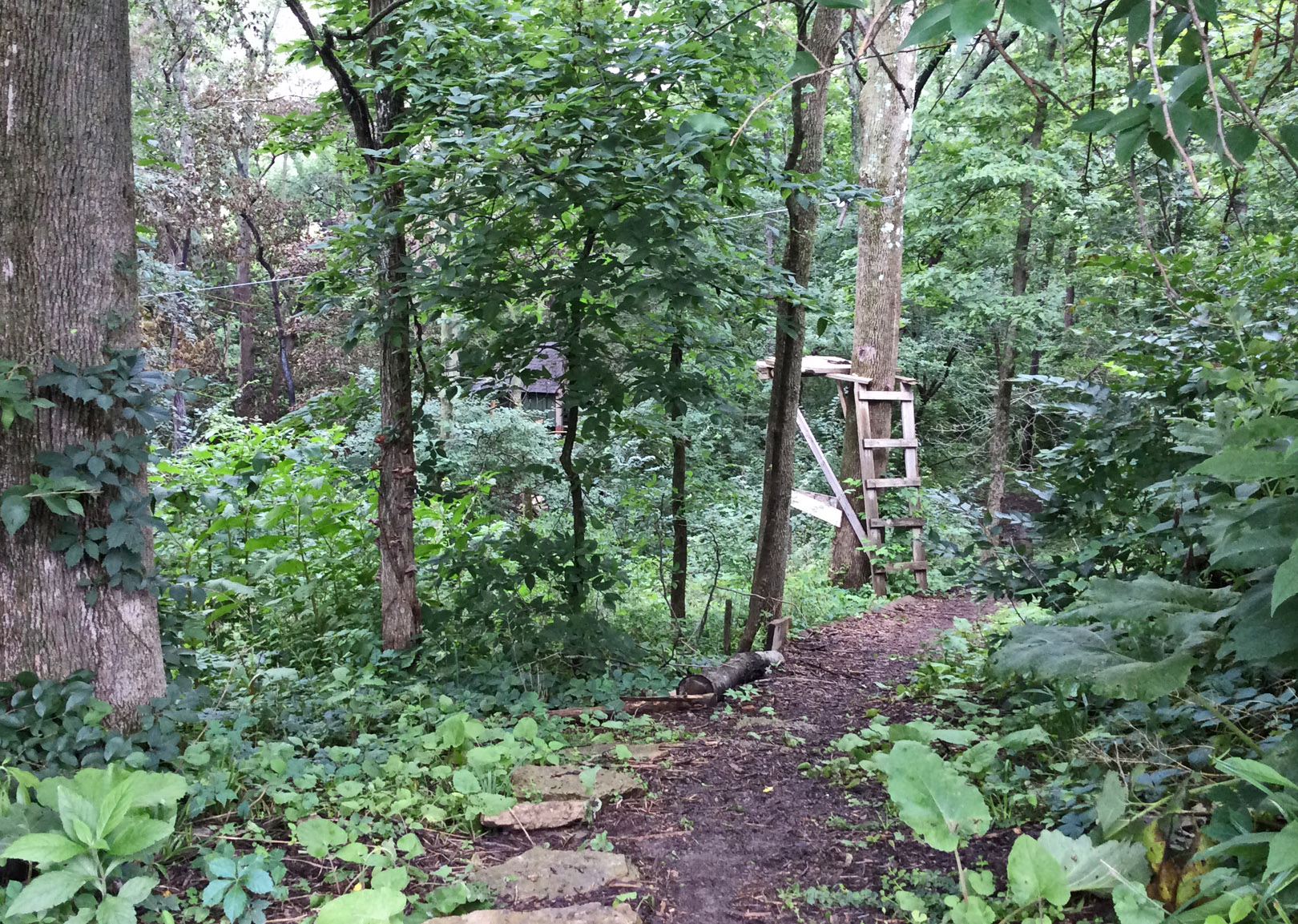
Just off the woods is the backyard terrace area where texture rules. In the lower area, we visited “the girls”. They often roam with Teresa as she works in the garden. I’m thinking how this might be a good addition to my own garden. Where else do you find an insecticide (insects are one of their favorite foods), a fertilizer, a tractor and a food provider wrapped up in one attractive package?
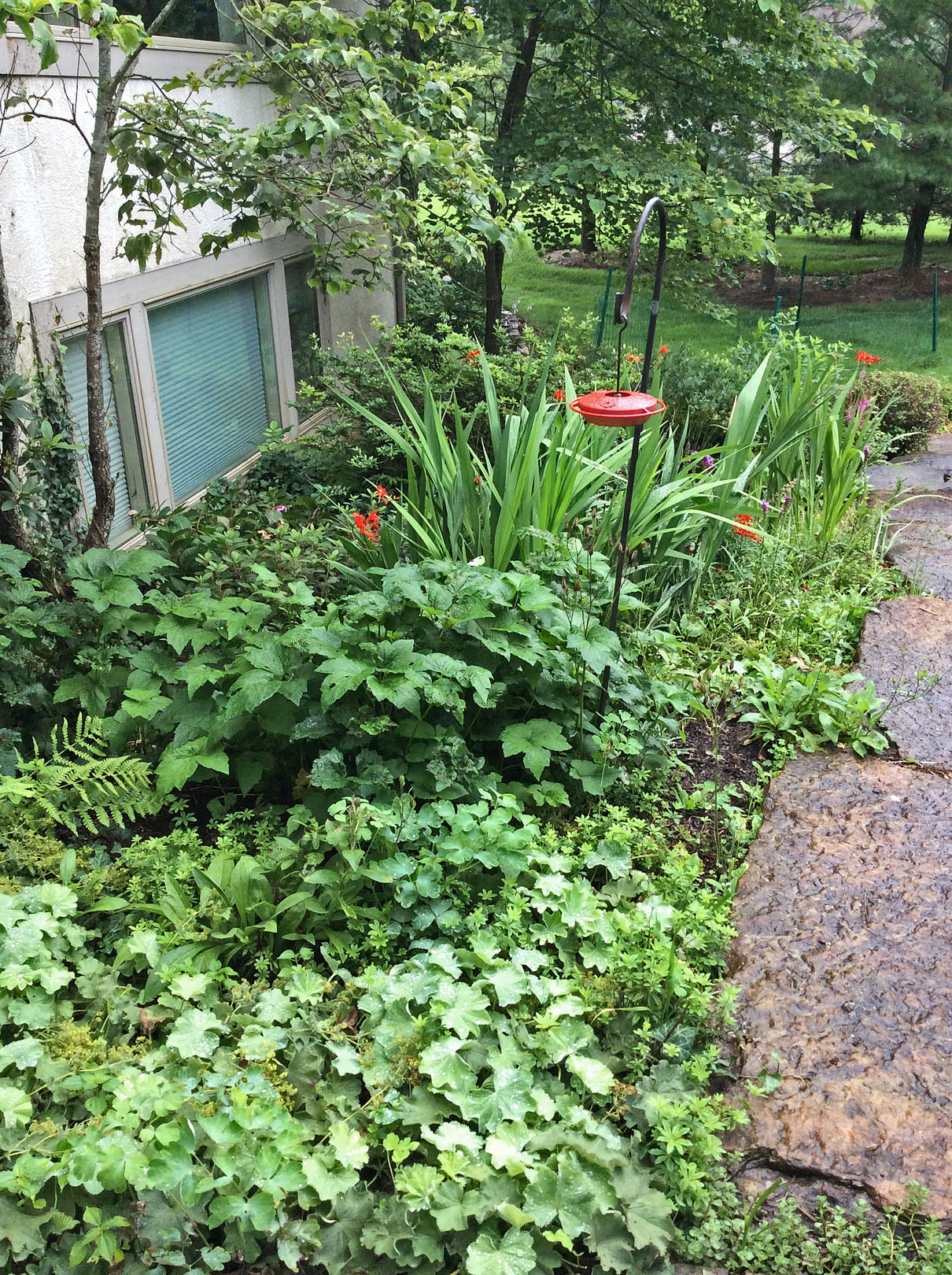
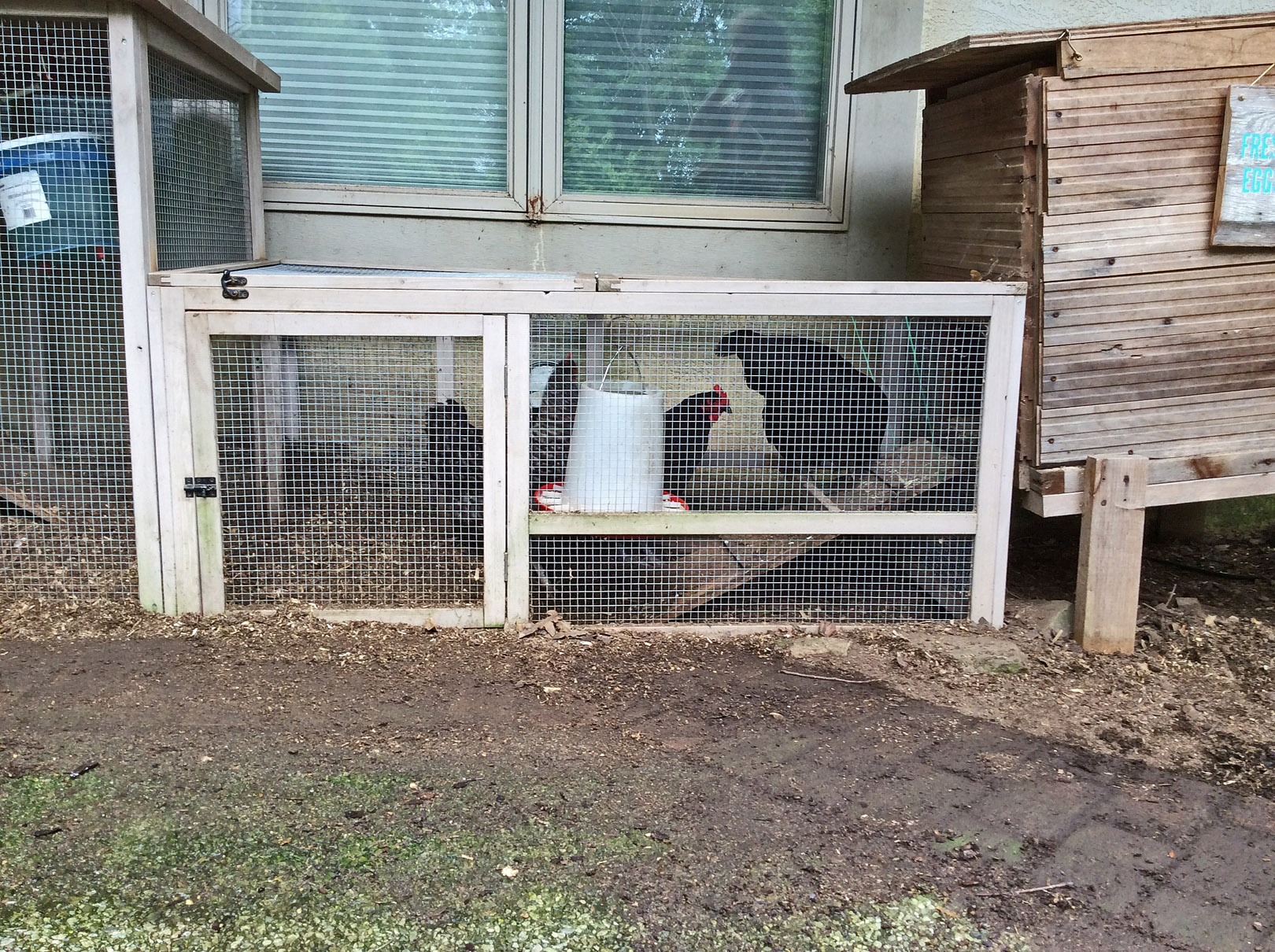
Coming out of the backyard into a semi-formal woodland garden, the rain started again. Time to say goodbye, accept some beautiful eggs, go home and bake.
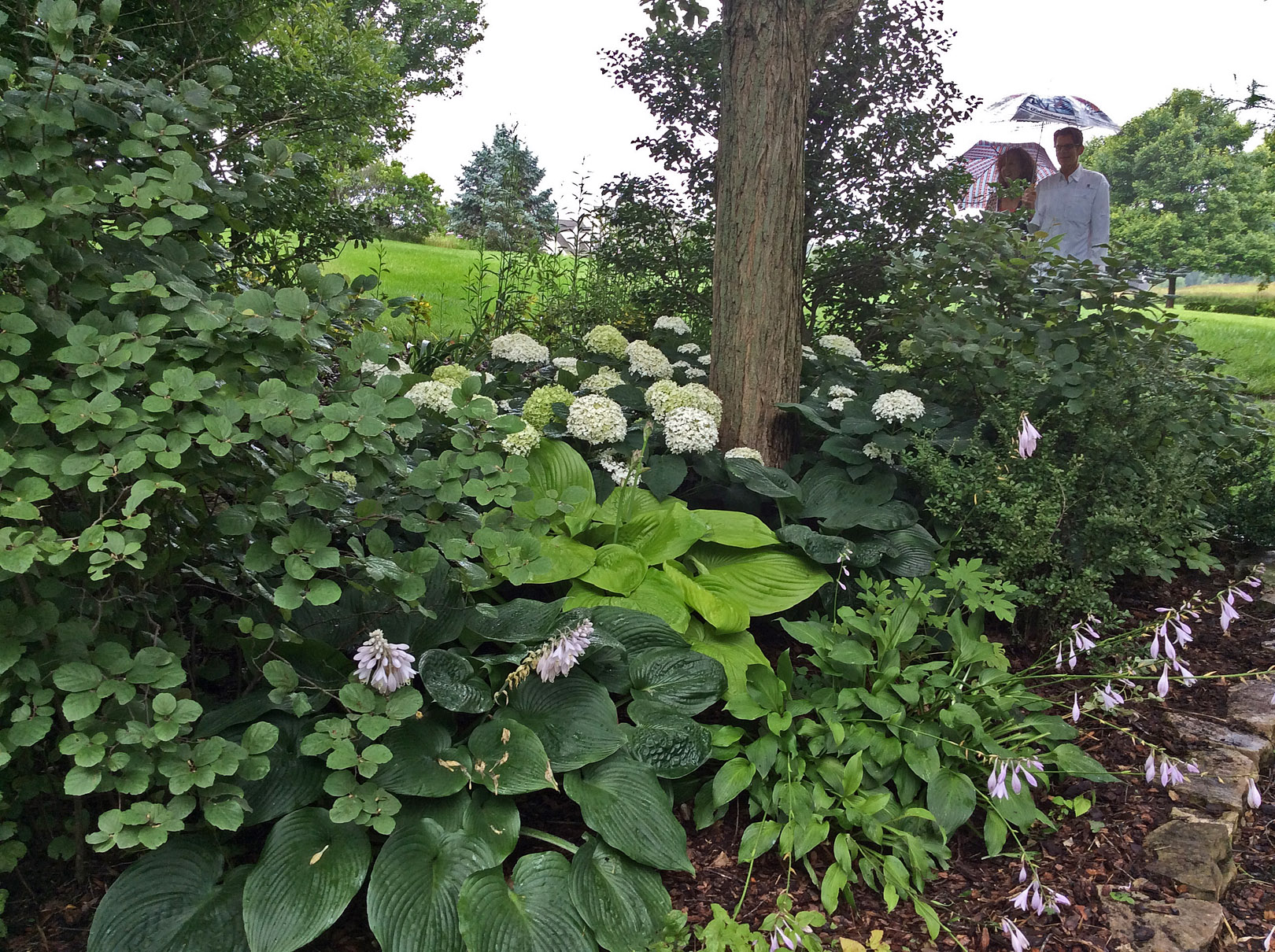
Wishing you beautiful moments in a garden…
by GardenLover | Jul 10, 2015 | Gardens to Drive
Travelogue: Lily Fest 2015
By Debra Knapke and Teresa Woodard
Debra’s observations:
Undaunted, Teresa negotiated Little Cola Road, a narrow road that was purported to be a two lane road on the last leg of our trip to Lily Fest 2015 near Logan in Ohio’s scenic Appalachia country. Fortunately, most cars were going to Lily Fest, so we had few passing encounters. When we left, we had many more passing encounters. I’m not fond of tiny cars, but I would have greatly appreciated being in a Smart car!
After parking, we walked down the path with our guide Sheri Quick. Sheri not only led us to Lily Fest, but she introduced us to Bobbi Bishop. She and her late husband Bruce started Lily Fest in 1992 as a small event to show off their gardens. Bruce’s spirit still guides the festival, and his gardens are an inspiration to Midwest gardeners.
So, what did I find exciting?
Daylilies of every kind! My current favorite type is the spider form. Below is a spider-form daylily peeking through the leaves of a variegated giant reed grass (Arundo donax ‘Variegata’)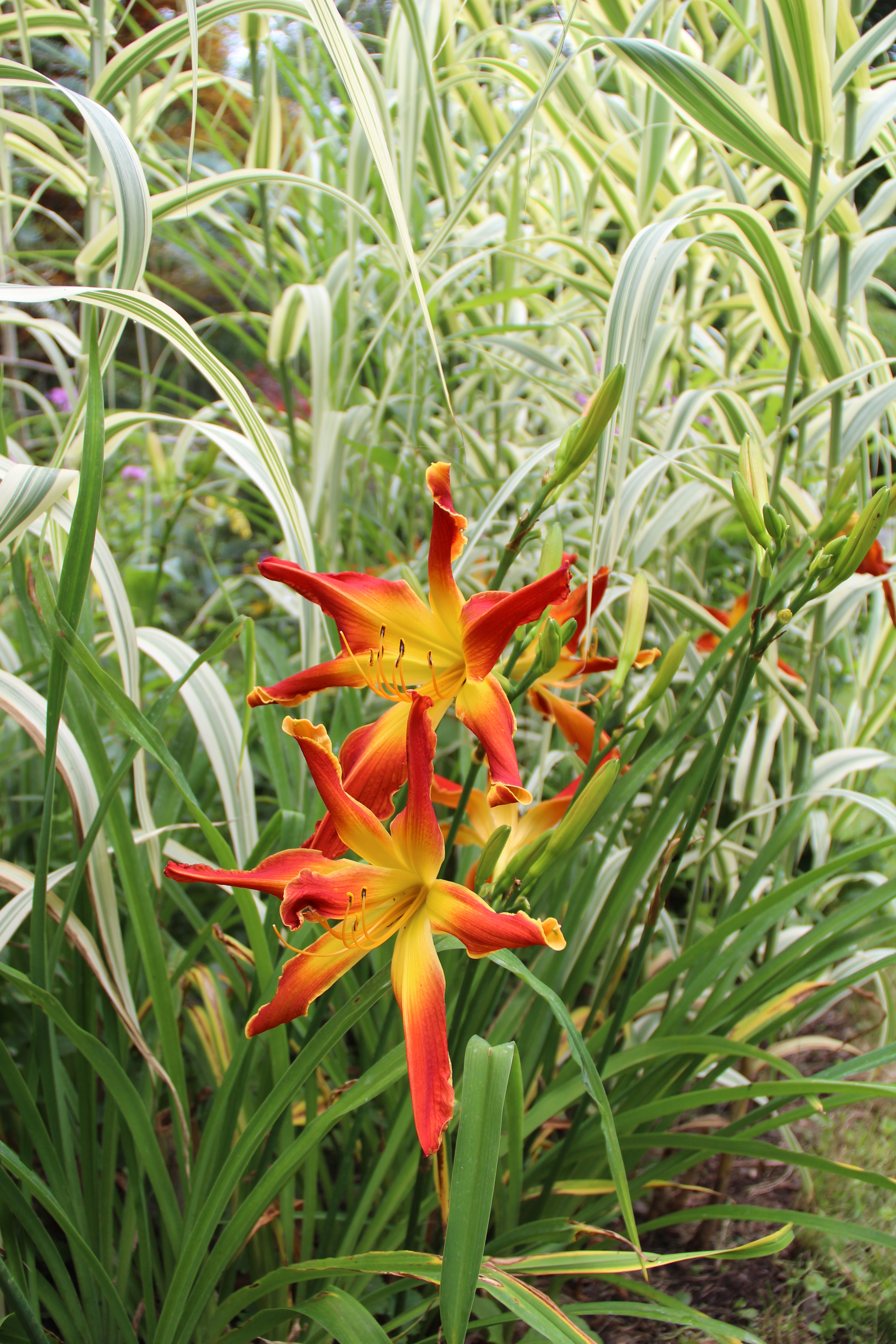
The gardens are a tapestry of green punctuated by blooms and varied-colored leaves. The bursts of color are balanced by the calming textural contrasts as evidenced below.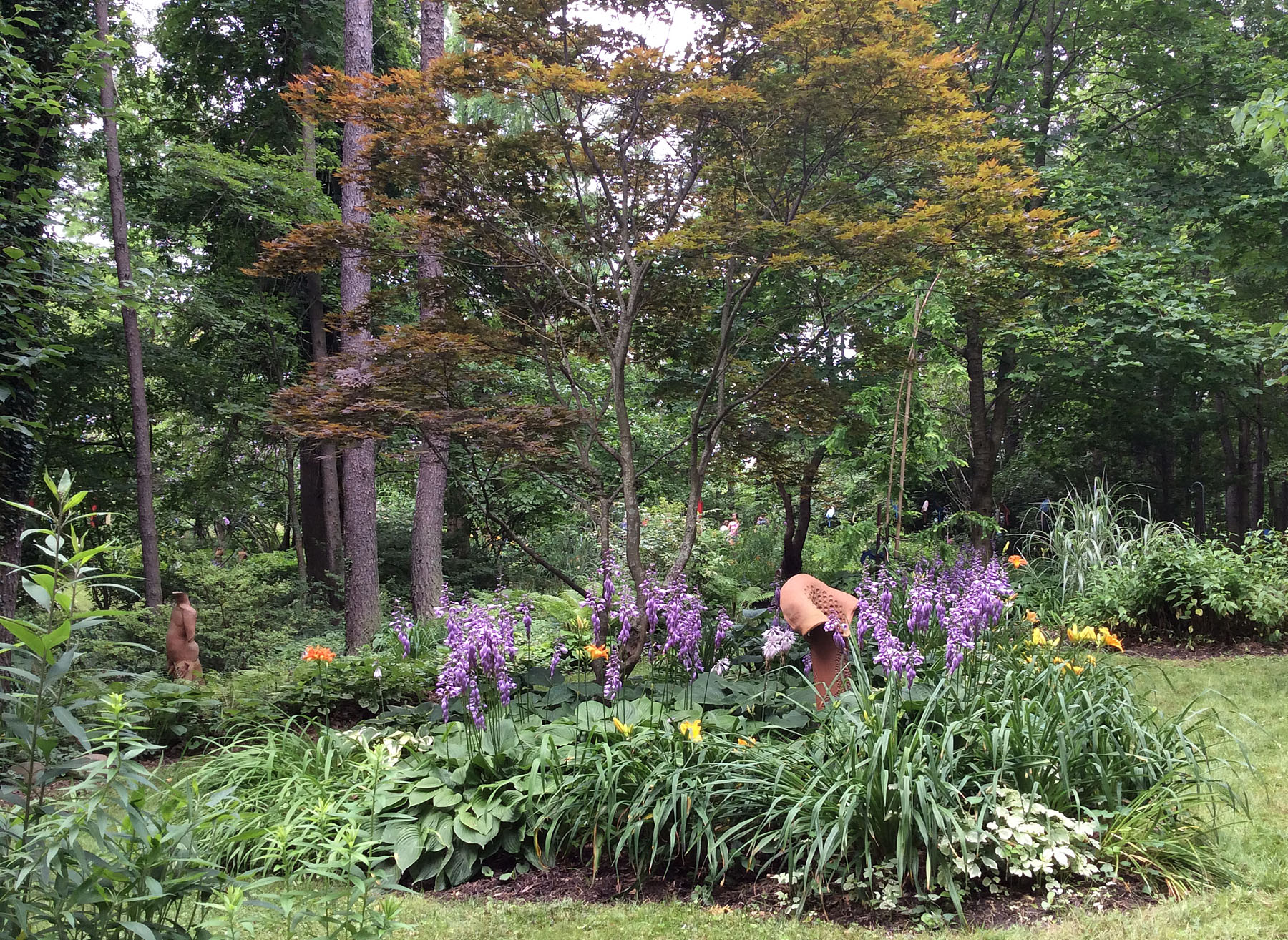
The art! Artful pieces are scattered throughout the garden. Below is a simple composition of shovels upended in the garden and painted. It is a subtle installation.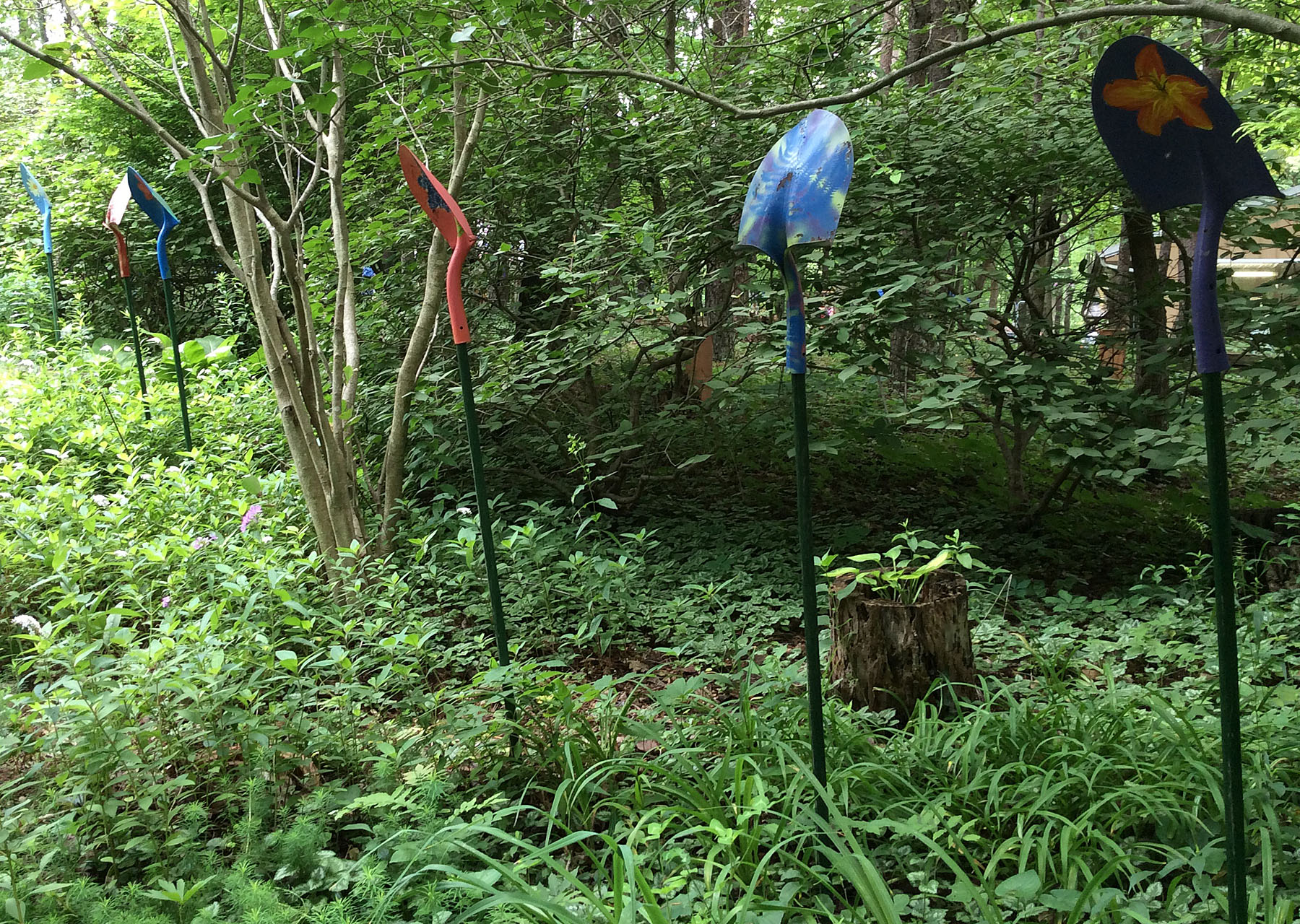
Many of the artists represented in the gardens were present in the booths that lined several pathways. I recognized some crafts people from other shows, but was happy to discover new adornments and ideas for the garden.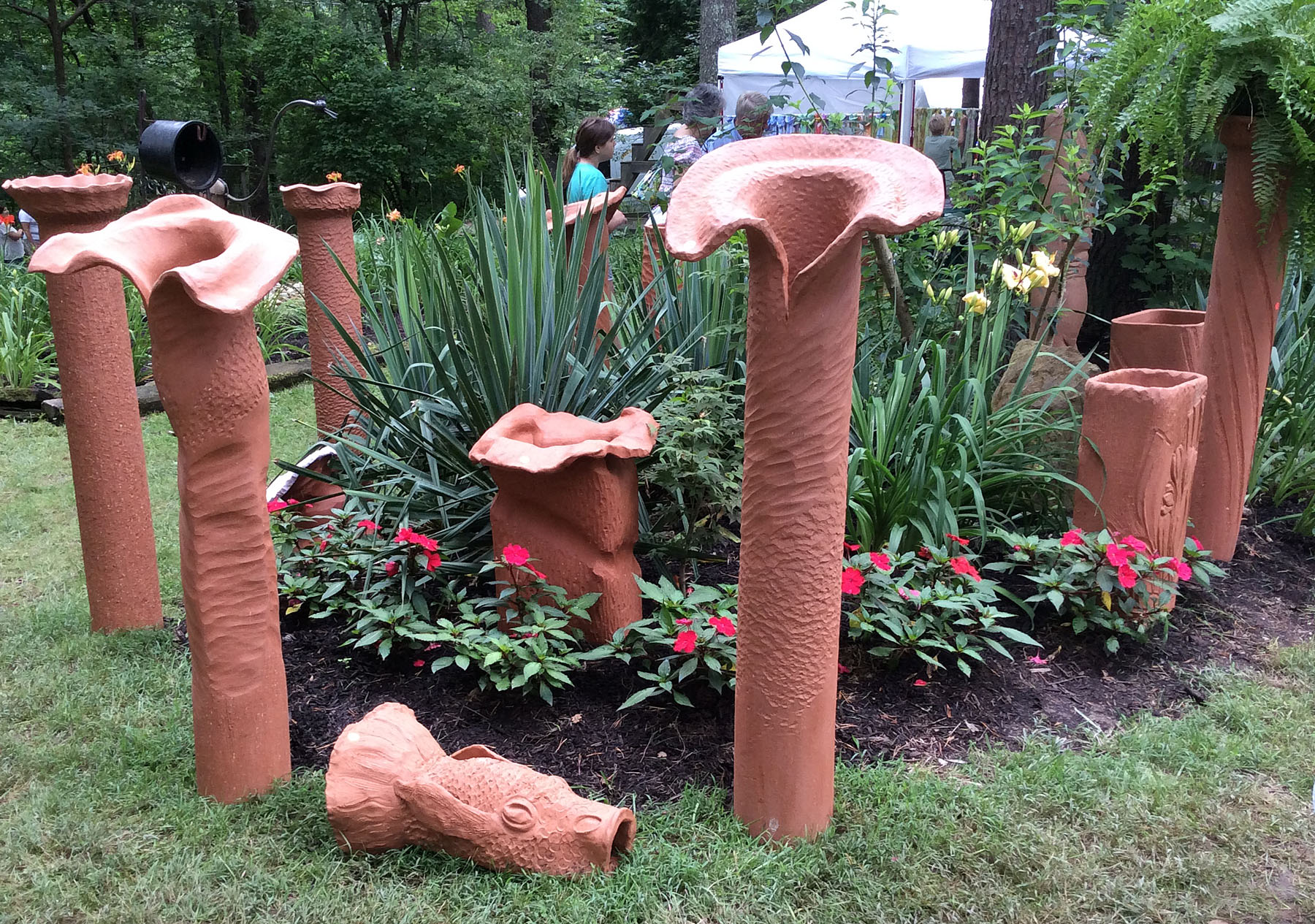
At the end of our visit, we passed one of the ponds. Visitors were sitting on benches and listening to the soulful flute music of Mark Thunderwalker Camden while viewing this rhapsody in pink: lotus, flamingos and a dusky Japanese maple.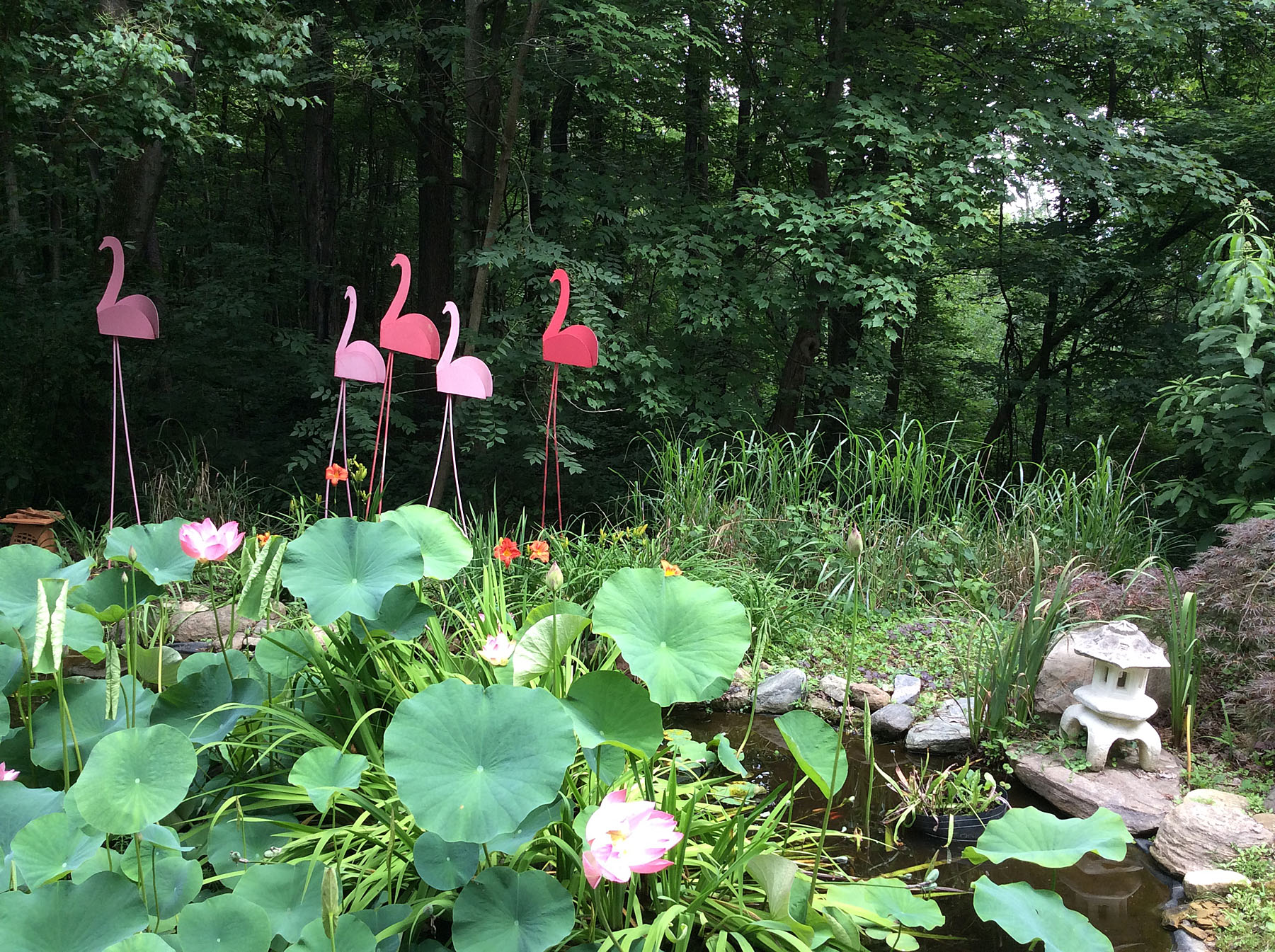
Oh, I did find some chocolate, which is a must at any festival.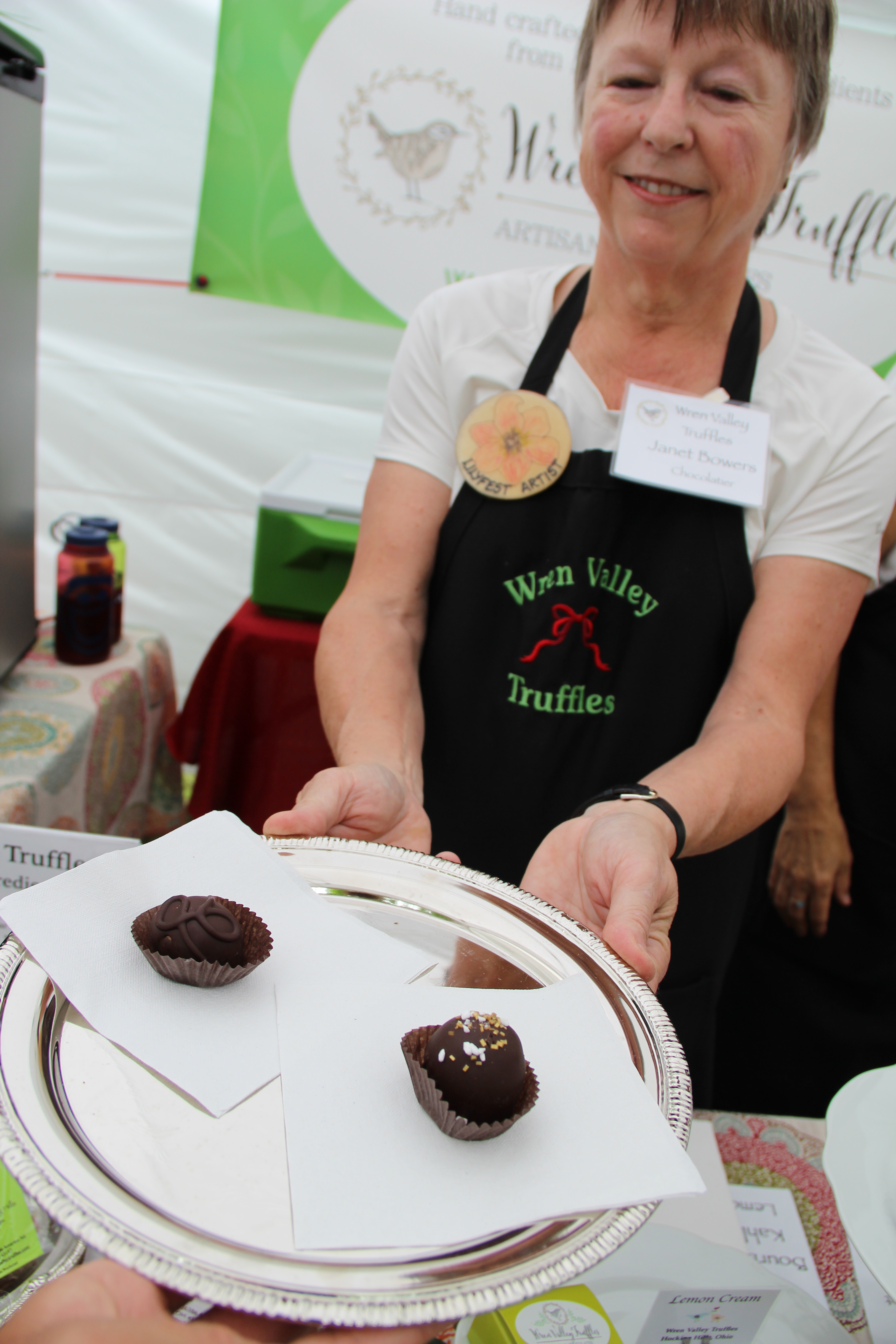
Teresa’s observations:
At Lily Fest, there’s a wonderful sense of community from the volunteers that helped us park cars to the greeters at the front gate to all the gardeners that volunteered for weeks prior to make the grounds so lovely.
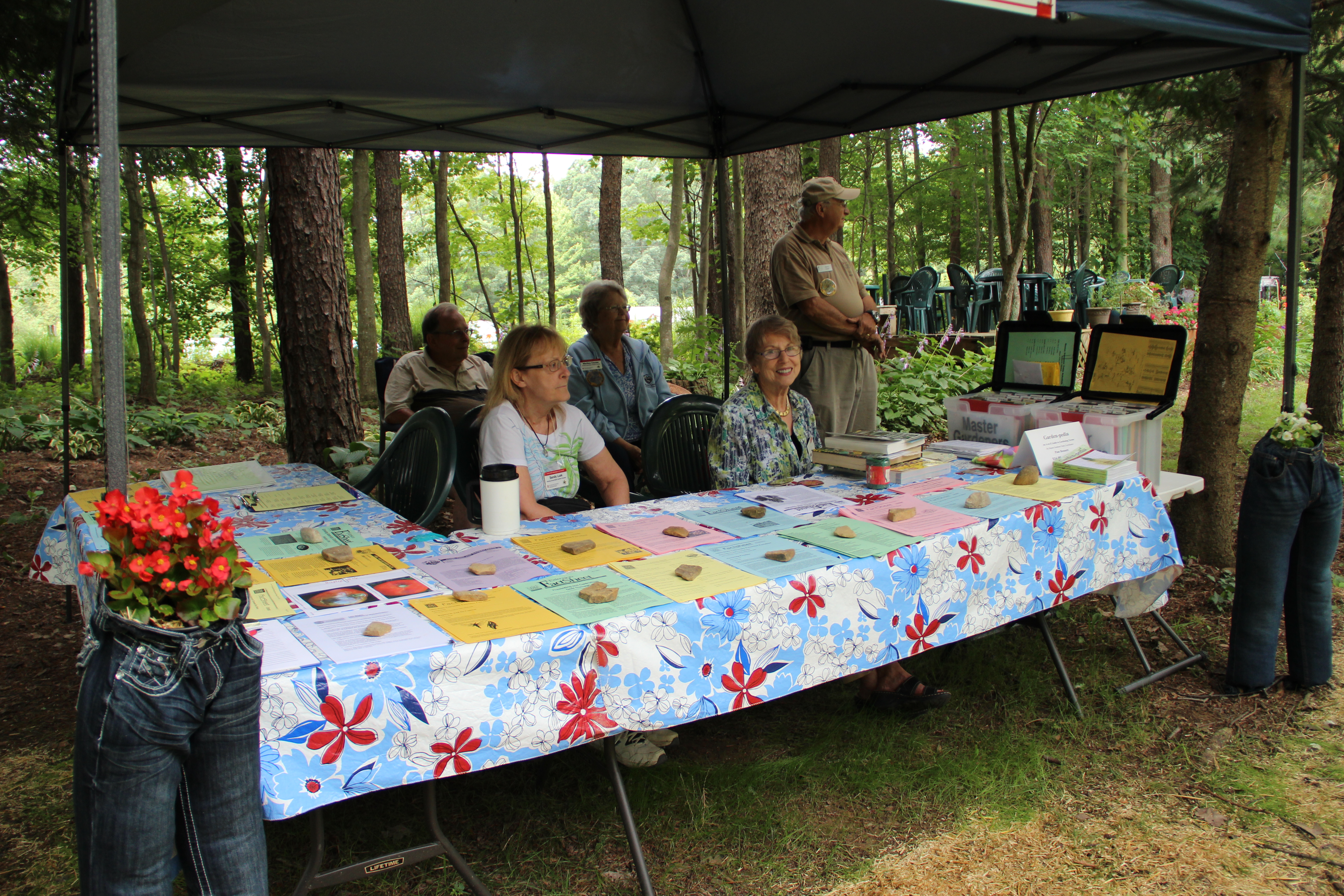 Like Deb, I also appreciated the selection of juried artists including many with lily-inspired pieces — lily glass sculptures, lily stone statues and lily ironwork.
Like Deb, I also appreciated the selection of juried artists including many with lily-inspired pieces — lily glass sculptures, lily stone statues and lily ironwork. 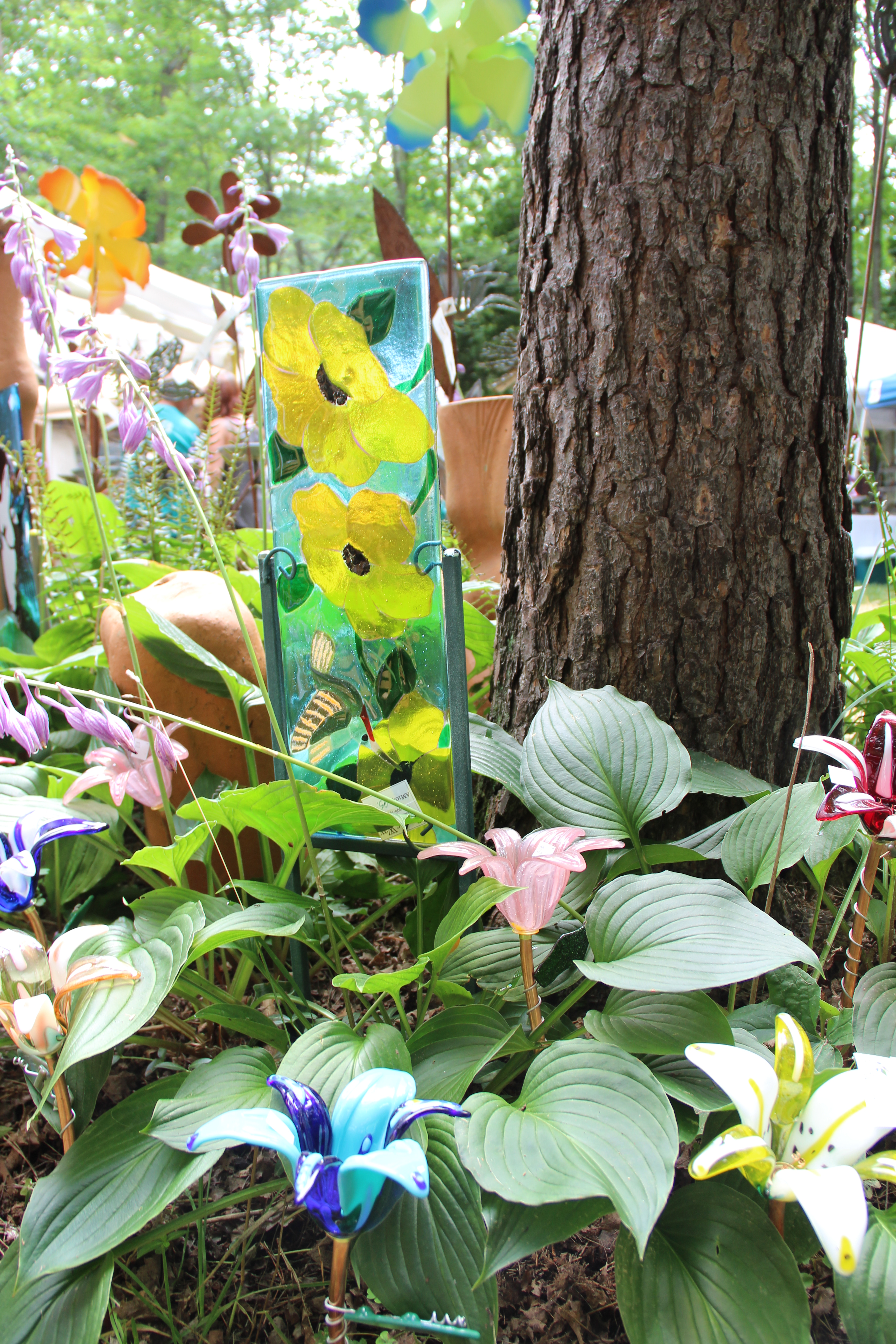
Lily Fest is also filled with plenty of garden whimsy from these kitschy garden pants to this charming cottage.
And, of course, we came to see the lilies!
Visit Lily Fest this weekend or check out these other upcoming Midwestern flower festivals:

 Next sad story concerns basil. I started my own plants this year in an effort to bypass the downy mildew disease that has plagued my favorite pesto herb. My 32 plants started off great. I kept them evenly moist and healthy with compost tea. Just as I was thinking to plant them out – late May – I noticed my plants had downy mildew.
Next sad story concerns basil. I started my own plants this year in an effort to bypass the downy mildew disease that has plagued my favorite pesto herb. My 32 plants started off great. I kept them evenly moist and healthy with compost tea. Just as I was thinking to plant them out – late May – I noticed my plants had downy mildew. Take a closer look and you can see the spores; the carriers of downy mildew to the next leaf or plant.
Take a closer look and you can see the spores; the carriers of downy mildew to the next leaf or plant. The below plant was doing well, but I was at a conference for a week and this is what I found when I returned.
The below plant was doing well, but I was at a conference for a week and this is what I found when I returned.
























